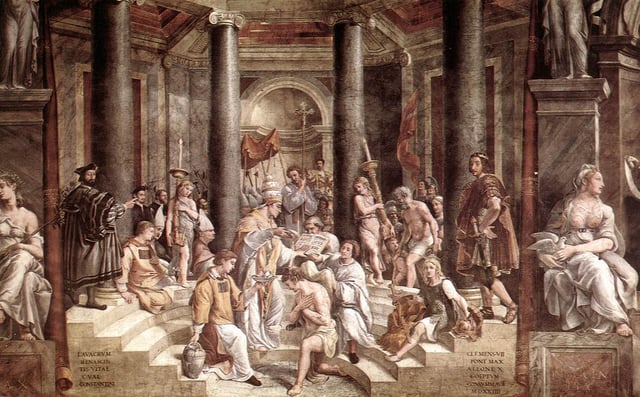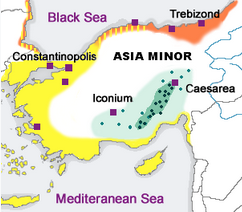Byzantine Empire

Byzantine Empire

Byzantine Empire Βασιλεία Ῥωμαίων Basileía Rhōmaíōna | |||||||||
|---|---|---|---|---|---|---|---|---|---|
| 395–1453b | |||||||||
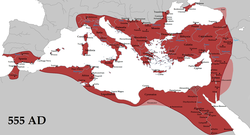 The empire in 555 under Justinian the Great, at its greatest extent since the fall of the Western Roman Empire (its vassals in pink) | |||||||||
| Capital | Constantinoplec (395–1204, 1261–1453) | ||||||||
| Common languages |
| ||||||||
| Religion | Eastern Orthodox Christianity (tolerated after the Edict of Milan in 313; state religion after 380) | ||||||||
| Notable emperors | |||||||||
• 395–408 | Arcadius | ||||||||
• 527–565 | Justinian I | ||||||||
• 610–641 | Heraclius | ||||||||
• 717–741 | Leo III | ||||||||
• 976–1025 | Basil II | ||||||||
• 1081–1118 | Alexios I Komnenos | ||||||||
• 1259–1282 | Michael VIII Palaiologos | ||||||||
• 1449–1453 | Constantine XI | ||||||||
| Historical era | Late Antiquity to Late Middle Ages | ||||||||
• First division of the Roman Empire (diarchy) | 1 April 286 | ||||||||
• Founding of Constantinople | 11 May 330 | ||||||||
• Final East–West division after the death of Theodosius I | 17 January 395 | ||||||||
• Nominal end of the Western Roman Empire | 25 April 480 | ||||||||
• Fourth Crusade; establishment of the Latin Empire | 12 April 1204 | ||||||||
• Reconquest of Constantinople by Palaiologos | 25 July 1261 | ||||||||
| 29 May 1453 | |||||||||
• Fall of Trebizond | 15 August 1461 | ||||||||
| Population | |||||||||
• 457 | 16,000,000d | ||||||||
• 565 | 19,000,000 | ||||||||
• 775 | 7,000,000 | ||||||||
• 1025 | 12,000,000 | ||||||||
• 1320 | 2,000,000 | ||||||||
| Currency | Solidus, histamenon and hyperpyron | ||||||||
| |||||||||
| |||||||||
The Byzantine Empire, also referred to as the Eastern Roman Empire or Byzantium, was the continuation of the Roman Empire in its eastern provinces during Late Antiquity and the Middle Ages, when its capital city was Constantinople (modern Istanbul, formerly Byzantium). It survived the fragmentation and fall of the Western Roman Empire in the 5th century AD and continued to exist for an additional thousand years until it fell to the Ottoman Turks in 1453.[2] During most of its existence, the empire was the most powerful economic, cultural and military force in Europe. "Byzantine Empire" is a term created after the end of the realm; its citizens continued to refer to their empire simply as the Roman Empire (Greek: Βασιλεία Ῥωμαίων, tr. Basileia Rhōmaiōn; Latin: Imperium Romanum),[3] or Romania (Ῥωμανία), and to themselves as "Romans".
Several signal events from the 4th to 6th centuries mark the period of transition during which the Roman Empire's Greek East and Latin West diverged. Constantine I (r. 324–337) reorganised the empire, made Constantinople the new capital and legalised Christianity. Under Theodosius I (r. 379–395), Christianity became the state religion and other religious practices were proscribed. In the reign of Heraclius (r. 610–641), the Empire's military and administration were restructured and adopted Greek for official use in place of Latin.[4] Although the Roman state continued and its traditions were maintained, modern historians distinguish Byzantium from ancient Rome insofar as it was centred on Constantinople, orientated towards Greek rather than Latin culture and characterised by Eastern Orthodox Christianity.[5]
The borders of the empire varied through cycles of decline and recovery. During the reign of Justinian I (r. 527–565), the empire reached its greatest extent, after reconquering much of the historically Roman western Mediterranean coast, including North Africa, Italy and Rome, which it held for two more centuries. The Byzantine–Sasanian War of 602–628 exhausted the empire's resources and during the Early Muslim conquests of the 7th century, lost its richest provinces, Egypt and Syria, to the Arab caliphate.[6] During the Macedonian dynasty (10th–11th centuries), the empire expanded again and experienced the two-century long Macedonian Renaissance, which came to an end with the loss of much of Asia Minor to the Seljuk Turks after the Battle of Manzikert in 1071. This battle opened the way for the Turks to settle in Anatolia.
The empire recovered during the Komnenian restoration and by the 12th century Constantinople was the largest and wealthiest European city.[7] The Byzantine Empire was delivered a mortal blow during the Fourth Crusade, when Constantinople was sacked in 1204 and the territories that the empire formerly governed were divided into competing Byzantine Greek and Latin realms. Despite the eventual recovery of Constantinople in 1261, the Byzantine Empire remained only one of several small rival states in the area for the final two centuries of its existence. Its remaining territories were progressively annexed by the Ottomans in the Byzantine–Ottoman wars over the 14th and 15th centuries. The Fall of Constantinople to the Ottoman Empire in 1453 ended the Byzantine Empire.[8] The last of the imperial Byzantine successor states, the Empire of Trebizond, would be conquered by the Ottomans eight years later in the 1461 Siege of Trebizond.[9]
Byzantine Empire Βασιλεία Ῥωμαίων Basileía Rhōmaíōna | |||||||||
|---|---|---|---|---|---|---|---|---|---|
| 395–1453b | |||||||||
 The empire in 555 under Justinian the Great, at its greatest extent since the fall of the Western Roman Empire (its vassals in pink) | |||||||||
| Capital | Constantinoplec (395–1204, 1261–1453) | ||||||||
| Common languages |
| ||||||||
| Religion | Eastern Orthodox Christianity (tolerated after the Edict of Milan in 313; state religion after 380) | ||||||||
| Notable emperors | |||||||||
• 395–408 | Arcadius | ||||||||
• 527–565 | Justinian I | ||||||||
• 610–641 | Heraclius | ||||||||
• 717–741 | Leo III | ||||||||
• 976–1025 | Basil II | ||||||||
• 1081–1118 | Alexios I Komnenos | ||||||||
• 1259–1282 | Michael VIII Palaiologos | ||||||||
• 1449–1453 | Constantine XI | ||||||||
| Historical era | Late Antiquity to Late Middle Ages | ||||||||
• First division of the Roman Empire (diarchy) | 1 April 286 | ||||||||
• Founding of Constantinople | 11 May 330 | ||||||||
• Final East–West division after the death of Theodosius I | 17 January 395 | ||||||||
• Nominal end of the Western Roman Empire | 25 April 480 | ||||||||
• Fourth Crusade; establishment of the Latin Empire | 12 April 1204 | ||||||||
• Reconquest of Constantinople by Palaiologos | 25 July 1261 | ||||||||
| 29 May 1453 | |||||||||
• Fall of Trebizond | 15 August 1461 | ||||||||
| Population | |||||||||
• 457 | 16,000,000d | ||||||||
• 565 | 19,000,000 | ||||||||
• 775 | 7,000,000 | ||||||||
• 1025 | 12,000,000 | ||||||||
• 1320 | 2,000,000 | ||||||||
| Currency | Solidus, histamenon and hyperpyron | ||||||||
| |||||||||
| |||||||||
Nomenclature
The first use of the term "Byzantine" to label the later years of the Roman Empire was in 1557, when the German historian Hieronymus Wolf published his work Corpus Historiæ Byzantinæ, a collection of historical sources. The term comes from "Byzantium", the name of the city to which Constantine moved his capital, leaving Rome, and rebuilt under the new name of Constantinople. The older name of the city would rarely be used from this point onward except in historical or poetic contexts. The publication in 1648 of the Byzantine du Louvre (Corpus Scriptorum Historiae Byzantinae), and in 1680 of Du Cange's Historia Byzantina further popularised the use of "Byzantine" among French authors, such as Montesquieu.[10] However, it was not until the mid-19th century that the term came into general use in the Western world.[11]
The Byzantine Empire was known to its inhabitants as the "Roman Empire", the "Empire of the Romans" (Latin: Imperium Romanum, Imperium Romanorum; Greek: Βασιλεία τῶν Ῥωμαίων Basileia tōn Rhōmaiōn, Ἀρχὴ τῶν Ῥωμαίων Archē tōn Rhōmaiōn), Romania (Latin: Romania; Greek: Ῥωμανία Rhōmania),[1] the Roman Republic (Latin: Res Publica Romana; Greek: Πολιτεία τῶν Ῥωμαίων Politeia tōn Rhōmaiōn), and also as "Rhōmais" (Greek: Ῥωμαΐς).[14] The inhabitants called themselves Romaioi and even as late as the 19th century Greeks typically referred to Modern Greek as Romaiika "Romaic."[15][16] After 1204 when the Byzantine Empire was mostly confined to its purely Greek provinces the term 'Hellenes' was increasingly used instead.[17]
While the Byzantine Empire had a multi-ethnic character during most of its history[18] and preserved Romano-Hellenistic traditions,[19] it became identified by its western and northern contemporaries with its increasingly predominant Greek element.[20] Western medieval sources also referred to the empire as the "Empire of the Greeks" (Latin: Imperium Graecorum) and to its emperor as Imperator Graecorum (Emperor of the Greeks);[21] these terms were used to distinguish it from the new kingdom that claimed the prestige of the classical Roman Empire in the West.[22]
No such distinction existed in the Islamic and Slavic worlds, where the Empire was more straightforwardly seen as the continuation of the Roman Empire. In the Islamic world, the Roman Empire was known primarily as Rûm.[23] The name millet-i Rûm, or "Roman nation," was used by the Ottomans through the 20th century to refer to the former subjects of the Byzantine Empire, that is, the Orthodox Christian community within Ottoman realms.
History
Early history
The Roman army succeeded in conquering many territories covering the Mediterranean region and coastal regions in southwestern Europe and north Africa. These territories were home to many different cultural groups, both urban populations and rural populations. Generally speaking, the eastern Mediterranean provinces were more urbanised than the western, having previously been united under the Macedonian Empire and Hellenised by the influence of Greek culture.[25]
The West also suffered more heavily from the instability of the 3rd century AD. This distinction between the established Hellenised East and the younger Latinised West persisted and became increasingly important in later centuries, leading to a gradual estrangement of the two worlds.[25]
An early instance of the partition of the Empire into East and West occurred in 293, when Emperor Diocletian created a new administrative system (the tetrarchy), to guarantee security in all endangered regions of his Empire. He associated himself with a co-emperor (Augustus), and each co-emperor then adopted a young colleague given the title of Caesar, to share in their rule and eventually to succeed the senior partner. Each tetrarch was in charge of a part of the Empire. The tetrarchy collapsed, however, in 313 and a few years later Constantine I reunited the two administrative divisions of the Empire as sole Augustus.[26]
Christianization and partition of the Empire

Restored section of the Theodosian Walls

After the death of Theodosius I in 395, the empire was again divided. The west collapsed in the 400s while the east ended with the capture of Constantinople 1453. The Western Roman Empire The Eastern Roman/Byzantine Empire
In 330, Constantine moved the seat of the Empire to Constantinople, which he founded as a second Rome on the site of Byzantium, a city strategically located on the trade routes between Europe and Asia and between the Mediterranean and the Black Sea. Constantine introduced important changes to the Empire's military, monetary, civil and religious institutions. In regards to his economic policies he has been accused by certain scholars of "reckless fiscality", but the gold solidus he introduced became a stable currency that transformed the economy and promoted development.[27]
Under Constantine, Christianity did not become the exclusive religion of the state, but enjoyed imperial preference since he supported it with generous privileges. Constantine established the principle that emperors could not settle questions of doctrine on their own, but should summon instead general ecclesiastical councils for that purpose. His convening of both the Synod of Arles and the First Council of Nicaea indicated his interest in the unity of the Church, and showcased his claim to be its head.[28] The rise of Christianity was briefly interrupted on the accession of the emperor Julian in 361, who made a determined effort to restore polytheism throughout the empire and was thus dubbed "Julian the Apostate" by the Church.[29] However, this was reversed when Julian was killed in battle in 363.[30]
Theodosius I (379–395) was the last Emperor to rule both the Eastern and Western halves of the Empire. In 391 and 392 he issued a series of edicts essentially banning pagan religion. Pagan festivals and sacrifices were banned, as was access to all pagan temples and places of worship.[31] The last Olympic Games are believed to have been held in 393.[32] In 395, Theodosius I bequeathed the imperial office jointly to his sons: Arcadius in the East and Honorius in the West, once again dividing Imperial administration. In the 5th century the Eastern part of the empire was largely spared the difficulties faced by the West – due in part to a more established urban culture and greater financial resources, which allowed it to placate invaders with tribute and pay foreign mercenaries. This success allowed Theodosius II to focus on the codification of Roman law and further fortification of the walls of Constantinople, which left the city impervious to most attacks until 1204.[33] Large portions of the Theodosian Walls are preserved to the present day.
To fend off the Huns, Theodosius had to pay an enormous annual tribute to Attila. His successor, Marcian, refused to continue to pay the tribute, but Attila had already diverted his attention to the Western Roman Empire. After Attila's death in 453, the Hun Empire collapsed, and many of the remaining Huns were often hired as mercenaries by Constantinople.[34]
Loss of the Western Roman Empire
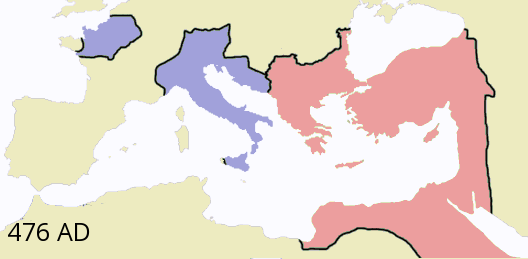
The West and East before the deposition of Romulus Augustulus in 476.
After the fall of Attila, the Eastern Empire enjoyed a period of peace, while the Western Empire continued to deteriorate due to the expanding migration and invasions of the "barbarians", most prominently the Germanic nations. The West's end is usually dated 476 when the East Germanic Roman foederati general Odoacer deposed the Western Emperor Romulus Augustulus, a year after the latter usurped the position from Julius Nepos.[35]
In 480 with the death of the Julius Nepos, Eastern Emperor Zeno became sole claimant to Emperor of the empire. Odoacer, now ruler of Italy, was nominally Zeno's subordinate but acted with complete autonomy, eventually providing support to a rebellion against the Emperor.[36]
Zeno negotiated with the invading Ostrogoths, who had settled in Moesia, convincing the Gothic king Theodoric to depart for Italy as magister militum per Italiam ("commander in chief for Italy") with the aim of deposing Odoacer. By urging Theodoric to conquer Italy, Zeno rid the Eastern Empire of an unruly subordinate (Odoacer) and moved another (Theodoric) further from the heart of the Empire. After Odoacer's defeat in 493, Theodoric ruled Italy de facto, although he was never recognised by the eastern emperors as "king" (rex).[36]
In 491, Anastasius I, an aged civil officer of Roman origin, became Emperor, but it was not until 497 that the forces of the new emperor effectively took the measure of Isaurian resistance.[37] Anastasius revealed himself as an energetic reformer and an able administrator. He introduced a new coinage system of the copper follis, the coin used in most everyday transactions.[38] He also reformed the tax system and permanently abolished the chrysargyron tax. The State Treasury contained the enormous sum of 320,000 lb (150,000 kg) of gold when Anastasius died in 518.[39]
Justinian dynasty

The Byzantine Empire's enlargement between the rise of Justinian (527; red) and his and Belisarius's death (565; orange). Belisarius contributed immensely to the expansion of the empire.
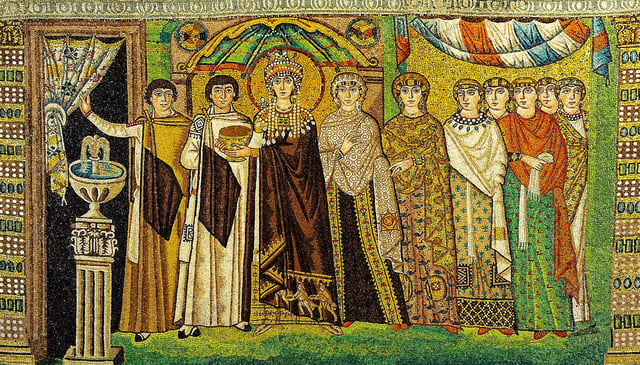
Empress Theodora and attendants (Mosaic from Basilica of San Vitale, 6th century).
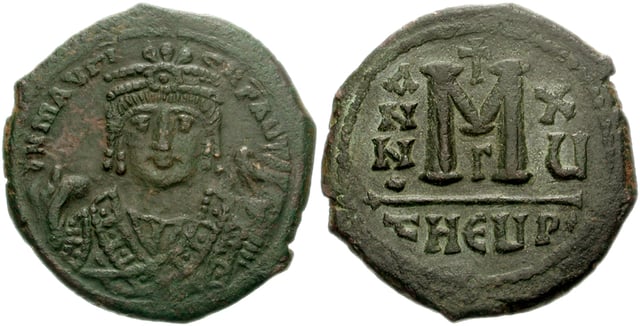
Follis with Maurice in consular uniform.
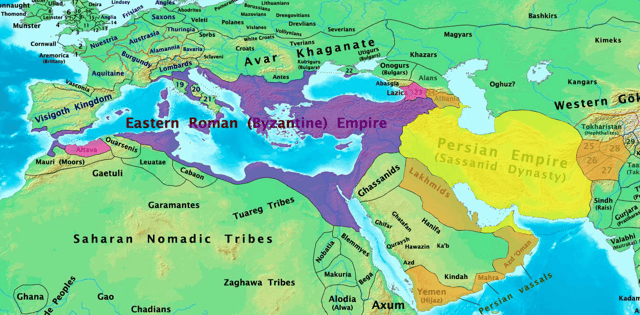
The Byzantine Empire in c. 600 during the reign of Maurice. Half of the Italian peninsula and most of southern Hispania were lost, but the eastern borders expanded gaining land from the Persians.
The Justinian dynasty was founded by Justin I, who though illiterate, rose through the ranks of the military to become Emperor in 518.[40] He was succeeded by his nephew Justinian I in 527, who may already have exerted effective control during Justin's reign.[41] One of the most important figures of late antiquity and possibly the last Roman emperor to speak Latin as a first language,[42] Justinian's rule constitutes a distinct epoch, marked by the ambitious but only partly realised renovatio imperii, or "restoration of the Empire".[43] His wife Theodora was particularly influential.[44]
In 529, Justinian appointed a ten-man commission chaired by John the Cappadocian to revise Roman law and create a new codification of laws and jurists' extracts, known as the "Corpus Juris Civilis"or the Justinian Code. In 534, the Corpus was updated and, along with the enactments promulgated by Justinian after 534, formed the system of law used for most of the rest of the Byzantine era.[45] The Corpus forms the basis of civil law of many modern states.[46]
In 532, attempting to secure his eastern frontier, Justinian signed a peace treaty with Khosrau I of Persia, agreeing to pay a large annual tribute to the Sassanids. In the same year, he survived a revolt in Constantinople (the Nika riots), which solidified his power but ended with the deaths of a reported 30,000 to 35,000 rioters on his orders.[47] The western conquests began in 533, as Justinian sent his general Belisarius to reclaim the former province of Africa from the Vandals, who had been in control since 429 with their capital at Carthage.[48] Their success came with surprising ease, but it was not until 548 that the major local tribes were subdued.[49]
In 535, a small Byzantine expedition to Sicily met with easy success, but the Goths soon stiffened their resistance, and victory did not come until 540, when Belisarius captured Ravenna, after successful sieges of Naples and Rome.[50] In 535–536, Theodahad sent Pope Agapetus I to Constantinople to request the removal of Byzantine forces from Sicily, Dalmatia, and Italy. Although Agapetus failed in his mission to sign a peace with Justinian, he succeeded in having the Monophysite Patriarch Anthimus I of Constantinople denounced, despite empress Theodora's support and protection.[51]
The Ostrogoths captured Rome in 546. Belisarius, who had been sent back to Italy in 544, was eventually recalled to Constantinople in 549.[52] The arrival of the Armenian eunuch Narses in Italy (late 551) with an army of 35,000 men marked another shift in Gothic fortunes. Totila was defeated at the Battle of Taginae and his successor, Teia, was defeated at the Battle of Mons Lactarius (October 552). Despite continuing resistance from a few Gothic garrisons and two subsequent invasions by the Franks and Alemanni, the war for the Italian peninsula was at an end.[53] In 551, Athanagild, a noble from Visigothic Hispania, sought Justinian's help in a rebellion against the king, and the emperor dispatched a force under Liberius, a successful military commander. The empire held on to a small slice of the Iberian Peninsula coast until the reign of Heraclius.[54]
In the east, the Roman–Persian Wars continued until 561 when the envoys of Justinian and Khosrau agreed on a 50-year peace.[55] By the mid-550s, Justinian had won victories in most theatres of operation, with the notable exception of the Balkans, which were subjected to repeated incursions from the Slavs and the Gepids. Tribes of Serbs and Croats were later resettled in the northwestern Balkans, during the reign of Heraclius.[56] Justinian called Belisarius out of retirement and defeated the new Hunnish threat. The strengthening of the Danube fleet caused the Kutrigur Huns to withdraw and they agreed to a treaty that allowed safe passage back across the Danube.[57]
Although polytheism had been suppressed by the state since at least the time of Constantine in the 4th century, traditional Greco-Roman culture was still influential in the Eastern empire in the 6th century.[58] Hellenistic philosophy began to be gradually amalgamated into newer Christian philosophy. Philosophers such as John Philoponus drew on neoplatonic ideas in addition to Christian thought and empiricism. Because of active paganism of its professors Justinian closed down the Neoplatonic Academy in 529. Other schools continued in Constantinople, Antioch and Alexandria which were the centers of Justinian's empire.[59] Hymns written by Romanos the Melodist marked the development of the Divine Liturgy, while the architects Isidore of Miletus and Anthemius of Tralles worked to complete the new Church of the Holy Wisdom, Hagia Sophia, which was designed to replace an older church destroyed during the Nika Revolt. Completed in 537, the Hagia Sophia stands today as one of the major monuments of Byzantine architectural history.[60] During the 6th and 7th centuries, the Empire was struck by a series of epidemics, which greatly devastated the population and contributed to a significant economic decline and a weakening of the Empire.[61]
After Justinian died in 565, his successor, Justin II, refused to pay the large tribute to the Persians. Meanwhile, the Germanic Lombards invaded Italy; by the end of the century, only a third of Italy was in Byzantine hands. Justin's successor, Tiberius II, choosing between his enemies, awarded subsidies to the Avars while taking military action against the Persians. Although Tiberius' general, Maurice, led an effective campaign on the eastern frontier, subsidies failed to restrain the Avars. They captured the Balkan fortress of Sirmium in 582, while the Slavs began to make inroads across the Danube.[62]
Maurice, who meanwhile succeeded Tiberius, intervened in a Persian civil war, placed the legitimate Khosrau II back on the throne, and married his daughter to him. Maurice's treaty with his new brother-in-law enlarged the territories of the Empire to the East and allowed the energetic Emperor to focus on the Balkans. By 602, a series of successful Byzantine campaigns had pushed the Avars and Slavs back across the Danube.[62] However, Maurice's refusal to ransom several thousand captives taken by the Avars, and his order to the troops to winter in the Danube, caused his popularity to plummet. A revolt broke out under an officer named Phocas, who marched the troops back to Constantinople; Maurice and his family were murdered while trying to escape.[63]
Shrinking borders
Early Heraclian dynasty
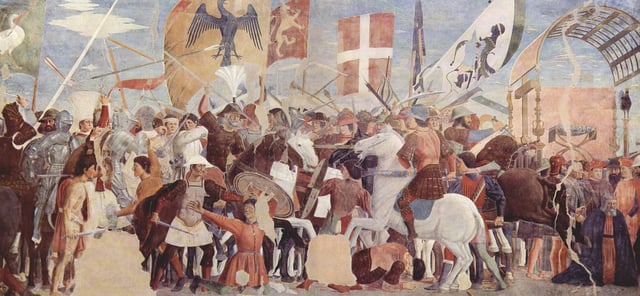
Battle between Heraclius and the Persians. Fresco by Piero della Francesca, c. 1452

By 650 (pictured) the empire had lost all its southern provinces, except the Exarchate of Africa, to the Rashidun Caliphate. At the same time the Slavs invaded and settled in the Balkans.
After Maurice's murder by Phocas, Khosrau used the pretext to reconquer the Roman province of Mesopotamia.[64] Phocas, an unpopular ruler invariably described in Byzantine sources as a "tyrant", was the target of a number of Senate-led plots. He was eventually deposed in 610 by Heraclius, who sailed to Constantinople from Carthage with an icon affixed to the prow of his ship.[65]
Following the accession of Heraclius, the Sassanid advance pushed deep into the Levant, occupying Damascus and Jerusalem and removing the True Cross to Ctesiphon.[66] The counter-attack launched by Heraclius took on the character of a holy war, and an acheiropoietos image of Christ was carried as a military standard[67] (similarly, when Constantinople was saved from a combined Avar–Sassanid–Slavic siege in 626, the victory was attributed to the icons of the Virgin that were led in procession by Patriarch Sergius about the walls of the city).[68] In this very siege of Constantinople of the year 626, amidst the climactic Byzantine–Sasanian War of 602–628, the combined Avar, Sassanid, and Slavic forces unsuccessfully besieged the Byzantine capital between June and July. After this, the Sassanid army was forced to withdraw to Anatolia. The loss came just after news had reached them of yet another Byzantine victory, where Heraclius's brother Theodore scored well against the Persian general Shahin.[69] Following this, Heraclius led an invasion into Sassanid Mesopotamia once again.
The main Sassanid force was destroyed at Nineveh in 627, and in 629 Heraclius restored the True Cross to Jerusalem in a majestic ceremony,[70] as he marched into the Sassanid capital of Ctesiphon, where anarchy and civil war reigned as a result of the enduring war. Eventually, the Persians were obliged to withdraw all armed forces and return Sassanid-ruled Egypt, the Levant and whatever imperial territories of Mesopotamia and Armenia were in Roman hands at the time of an earlier peace treaty in c. 595. The war had exhausted both the Byzantines and Sassanids, however, and left them extremely vulnerable to the Muslim forces that emerged in the following years.[71] The Byzantines suffered a crushing defeat by the Arabs at the Battle of Yarmouk in 636, while Ctesiphon fell in 637.[72]
First Arab Siege of Constantinople (674–678) and the theme system

Greek fire was first used by the Byzantine Navy during the Byzantine–Arab Wars (from the Madrid Skylitzes, Biblioteca Nacional de España, Madrid).
The Arabs, now firmly in control of Syria and the Levant, sent frequent raiding parties deep into Asia Minor, and in 674–678 laid siege to Constantinople itself. The Arab fleet was finally repulsed through the use of Greek fire, and a thirty-years' truce was signed between the Empire and the Umayyad Caliphate.[73] However, the Anatolian raids continued unabated, and accelerated the demise of classical urban culture, with the inhabitants of many cities either refortifying much smaller areas within the old city walls, or relocating entirely to nearby fortresses.[74] Constantinople itself dropped substantially in size, from 500,000 inhabitants to just 40,000–70,000, and, like other urban centres, it was partly ruralised. The city also lost the free grain shipments in 618, after Egypt fell first to the Persians and then to the Arabs, and public wheat distribution ceased.[75]
The void left by the disappearance of the old semi-autonomous civic institutions was filled by the system called theme, which entailed dividing Asia Minor into "provinces" occupied by distinct armies that assumed civil authority and answered directly to the imperial administration. This system may have had its roots in certain ad hoc measures taken by Heraclius, but over the course of the 7th century it developed into an entirely new system of imperial governance.[76] The massive cultural and institutional restructuring of the Empire consequent on the loss of territory in the 7th century has been said to have caused a decisive break in east Mediterranean Romanness and that the Byzantine state is subsequently best understood as another successor state rather than a real continuation of the Roman Empire.[77]
Late Heraclian dynasty
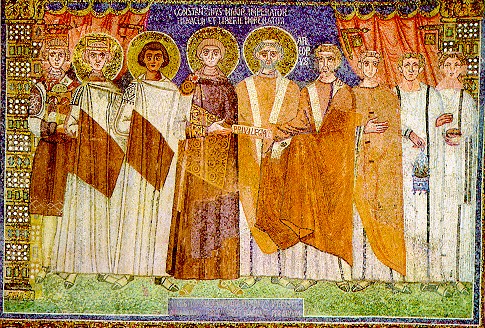
Constantine IV and his retinue, mosaic in Basilica of Sant'Apollinare in Classe.
The withdrawal of large numbers of troops from the Balkans to combat the Persians and then the Arabs in the east opened the door for the gradual southward expansion of Slavic peoples into the peninsula, and, as in Asia Minor, many cities shrank to small fortified settlements.[78] In the 670s, the Bulgars were pushed south of the Danube by the arrival of the Khazars. In 680, Byzantine forces sent to disperse these new settlements were defeated.[79]
In 681, Constantine IV signed a treaty with the Bulgar khan Asparukh, and the new Bulgarian state assumed sovereignty over a number of Slavic tribes that had previously, at least in name, recognised Byzantine rule.[79] In 687–688, the final Heraclian emperor, Justinian II, led an expedition against the Slavs and Bulgarians, and made significant gains, although the fact that he had to fight his way from Thrace to Macedonia demonstrates the degree to which Byzantine power in the north Balkans had declined.[80]
Justinian II attempted to break the power of the urban aristocracy through severe taxation and the appointment of "outsiders" to administrative posts. He was driven from power in 695, and took shelter first with the Khazars and then with the Bulgarians. In 705, he returned to Constantinople with the armies of the Bulgarian khan Tervel, retook the throne, and instituted a reign of terror against his enemies. With his final overthrow in 711, supported once more by the urban aristocracy, the Heraclian dynasty came to an end.[81]
Second Arab Siege of Constantinople (717–718) and the Isaurian dynasty

The Byzantine Empire at the accession of Leo III, c. 717. Striped indicates area raided by the Umayyads.
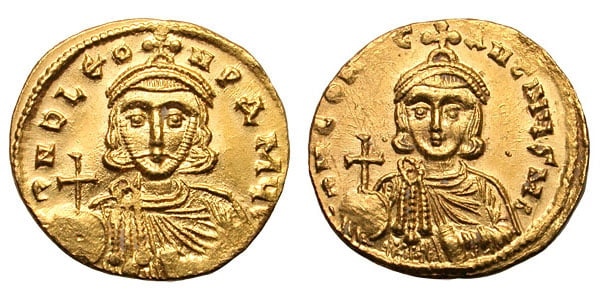
Gold solidus of Leo III (left), and his son and heir, Constantine V (right).
In 717 the Umayyad Caliphate launched the Siege of Constantinople (717–718) which lasted for one year. However, the combination of Leo III the Isaurian's military genius, the Byzantines' use of Greek Fire, a cold winter in 717–718, and Byzantine diplomacy with the Khan Tervel of Bulgaria resulted in a Byzantine victory. After Leo III turned back the Muslim assault in 718, he addressed himself to the task of reorganising and consolidating the themes in Asia Minor. In 740 a major Byzantine victory took place at the Battle of Akroinon where the Byzantines destroyed the Umayyad army once again.
Leo III the Isaurian's son and successor, Constantine V, won noteworthy victories in northern Syria and also thoroughly undermined Bulgarian strength.[82] In 746, profiting by the unstable conditions in the Umayyad Caliphate, which was falling apart under Marwan II, Constantine V invaded Syria and captured Germanikeia and the Battle of Keramaia resulted in a major Byzantine naval victory over the Umayyad fleet. Coupled with military defeats on other fronts of the Caliphate and internal instability, Umayyad expansion came to an end.
Religious dispute over iconoclasm
The 8th and early 9th centuries were also dominated by controversy and religious division over Iconoclasm, which was the main political issue in the Empire for over a century. Icons (here meaning all forms of religious imagery) were banned by Leo and Constantine from around 730, leading to revolts by iconodules (supporters of icons) throughout the empire. After the efforts of empress Irene, the Second Council of Nicaea met in 787 and affirmed that icons could be venerated but not worshiped. Irene is said to have endeavoured to negotiate a marriage between herself and Charlemagne, but, according to Theophanes the Confessor, the scheme was frustrated by Aetios, one of her favourites.[83]
In the early 9th century, Leo V reintroduced the policy of iconoclasm, but in 843 empress Theodora restored the veneration of icons with the help of Patriarch Methodios.[84] Iconoclasm played a part in the further alienation of East from West, which worsened during the so-called Photian schism, when Pope Nicholas I challenged the elevation of Photios to the patriarchate.[85]
Macedonian dynasty and resurgence (867–1025)

The Byzantine Empire, c. 867
The accession of Basil I to the throne in 867 marks the beginning of the Macedonian dynasty, which would rule for the next two and a half centuries. This dynasty included some of the most able emperors in Byzantium's history, and the period is one of revival and resurgence. The Empire moved from defending against external enemies to reconquest of territories formerly lost.[86]
In addition to a reassertion of Byzantine military power and political authority, the period under the Macedonian dynasty is characterised by a cultural revival in spheres such as philosophy and the arts. There was a conscious effort to restore the brilliance of the period before the Slavic and subsequent Arab invasions, and the Macedonian era has been dubbed the "Golden Age" of Byzantium.[86] Although the Empire was significantly smaller than during the reign of Justinian, it had regained significant strength, as the remaining territories were less geographically dispersed and more politically, economically, and culturally integrated.
Wars against the Abbasids
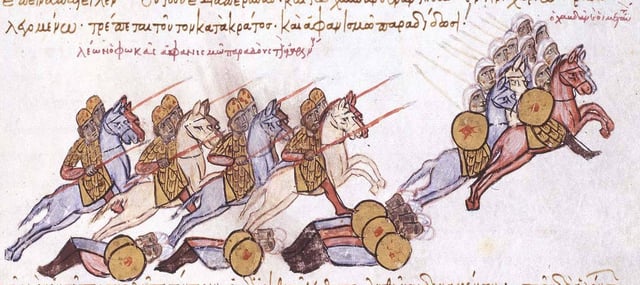
The general Leo Phokas defeats the Hamdanid Emirate of Aleppo at Andrassos in 960, from the Madrid Skylitzes.
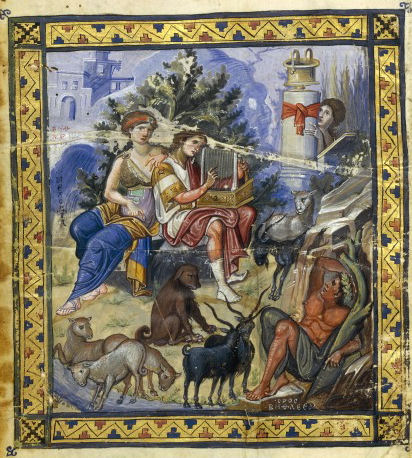
The military successes of the 10th century were coupled with a major cultural revival, the so-called Macedonian Renaissance. Miniature from the Paris Psalter, an example of Hellenistic-influenced art.
Taking advantage of the Empire's weakness after the Revolt of Thomas the Slav in the early 820s, the Arabs re-emerged and captured Crete. They also successfully attacked Sicily, but in 863 general Petronas gained a decisive victory against Umar al-Aqta, the emir of Melitene (Malatya). Under the leadership of emperor Krum, the Bulgarian threat also re-emerged, but in 815–816 Krum's son, Omurtag, signed a peace treaty with Leo V.[87]
In the 830s Abbasid Caliphate started military excursions culminating with a victory in the Sack of Amorium. The Byzantines then attacked back and sacked Damietta in Egypt. Later the Abbasid Caliphate responded by sending their troops into Anatolia again, sacking and marauding until they were eventually annihilated by the Byzantines in 863.
In the early years of Basil I's reign, Arab raids on the coasts of Dalmatia were successfully repelled, and the region once again came under secure Byzantine control. This enabled Byzantine missionaries to penetrate to the interior and convert the Serbs and the principalities of modern-day Herzegovina and Montenegro to Orthodox Christianity.[88]
By contrast, the Byzantine position in Southern Italy was gradually consolidated so that by 873 Bari was once again under Byzantine rule,[88] and most of Southern Italy would remain in the Empire for the next 200 years.[89] On the more important eastern front, the Empire rebuilt its defences and went on the offensive. The Paulicians were defeated and their capital of Tephrike (Divrigi) taken, while the offensive against the Abbasid Caliphate began with the recapture of Samosata.[88]
Under Basil's son and successor, Leo VI the Wise, the gains in the east against the now-weak Abbasid Caliphate continued. However, Sicily was lost to the Arabs in 902, and in 904 Thessaloniki, the Empire's second city, was sacked by an Arab fleet. The naval weakness of the Empire was rectified. Despite this revenge the Byzantines were still unable to strike a decisive blow against the Muslims, who inflicted a crushing defeat on the imperial forces when they attempted to regain Crete in 911.[90]
The death of the Bulgarian tsar Simeon I in 927 severely weakened the Bulgarians, allowing the Byzantines to concentrate on the eastern front.[91] Melitene was permanently recaptured in 934, and in 943 the famous general John Kourkouas continued the offensive in Mesopotamia with some noteworthy victories, culminating in the reconquest of Edessa. Kourkouas was especially celebrated for returning to Constantinople the venerated Mandylion, a relic purportedly imprinted with a portrait of Christ.[92]
The soldier-emperors Nikephoros II Phokas (r. 963–969) and John I Tzimiskes (969–976) expanded the empire well into Syria, defeating the emirs of north-west Iraq. The great city of Aleppo was taken by Nikephoros in 962 and the Arabs were decisively expelled from Crete in 963. The recapture of Crete put an end to Arab raids in the Aegean allowing mainland Greece to flourish once again. Cyprus was permanently retaken in 965 and the successes of Nikephoros culminated in 969 with the recapture of Antioch, which he incorporated as a province of the Empire.[93] His successor John Tzimiskes recaptured Damascus, Beirut, Acre, Sidon, Caesarea, and Tiberias, putting Byzantine armies within striking distance of Jerusalem, although the Muslim power centres in Iraq and Egypt were left untouched.[94] After much campaigning in the north, the last Arab threat to Byzantium, the rich province of Sicily, was targeted in 1025 by Basil II, who died before the expedition could be completed. Nevertheless, by that time the Empire stretched from the straits of Messina to the Euphrates and from the Danube to Syria.[95]
Wars against the Bulgarian Empire
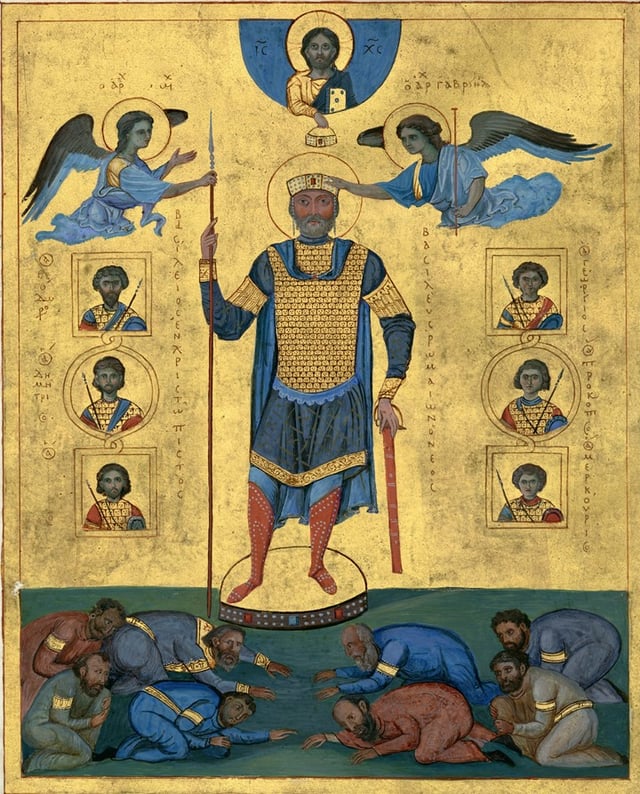
Emperor Basil II (r. 976–1025)

The extent of the Empire under Basil II
The traditional struggle with the See of Rome continued through the Macedonian period, spurred by the question of religious supremacy over the newly Christianised state of Bulgaria.[86] Ending eighty years of peace between the two states, the powerful Bulgarian tsar Simeon I invaded in 894 but was pushed back by the Byzantines, who used their fleet to sail up the Black Sea to attack the Bulgarian rear, enlisting the support of the Hungarians.[96] The Byzantines were defeated at the Battle of Boulgarophygon in 896, however, and agreed to pay annual subsidies to the Bulgarians.[90]
Leo the Wise died in 912, and hostilities soon resumed as Simeon marched to Constantinople at the head of a large army.[97] Although the walls of the city were impregnable, the Byzantine administration was in disarray and Simeon was invited into the city, where he was granted the crown of basileus (emperor) of Bulgaria and had the young emperor Constantine VII marry one of his daughters. When a revolt in Constantinople halted his dynastic project, he again invaded Thrace and conquered Adrianople.[98] The Empire now faced the problem of a powerful Christian state within a few days' marching distance from Constantinople,[86] as well as having to fight on two fronts.[90]
A great imperial expedition under Leo Phocas and Romanos I Lekapenos ended with another crushing Byzantine defeat at the Battle of Achelous in 917, and the following year the Bulgarians were free to ravage northern Greece. Adrianople was plundered again in 923, and a Bulgarian army laid siege to Constantinople in 924. Simeon died suddenly in 927, however, and Bulgarian power collapsed with him. Bulgaria and Byzantium entered a long period of peaceful relations, and the Empire was now free to concentrate on the eastern front against the Muslims.[99] In 968, Bulgaria was overrun by the Rus' under Sviatoslav I of Kiev, but three years later, John I Tzimiskes defeated the Rus' and re-incorporated Eastern Bulgaria into the Byzantine Empire.[100]
Bulgarian resistance revived under the rule of the Cometopuli dynasty, but the new Emperor Basil II (r. 976–1025) made the submission of the Bulgarians his primary goal.[101] Basil's first expedition against Bulgaria, however, resulted in a defeat at the Gates of Trajan. For the next few years, the emperor would be preoccupied with internal revolts in Anatolia, while the Bulgarians expanded their realm in the Balkans. The war dragged on for nearly twenty years. The Byzantine victories of Spercheios and Skopje decisively weakened the Bulgarian army, and in annual campaigns, Basil methodically reduced the Bulgarian strongholds.[101] At the Battle of Kleidion in 1014 the Bulgarians were annihilated: their army was captured, and it is said that 99 out of every 100 men were blinded, with the hundredth man left with one eye so he could lead his compatriots home. When Tsar Samuil saw the broken remains of his once formidable army, he died of shock. By 1018, the last Bulgarian strongholds had surrendered, and the country became part of the Empire.[101] This victory restored the Danube frontier, which had not been held since the days of the Emperor Heraclius.[95]
Relations with the Kievan Rus'
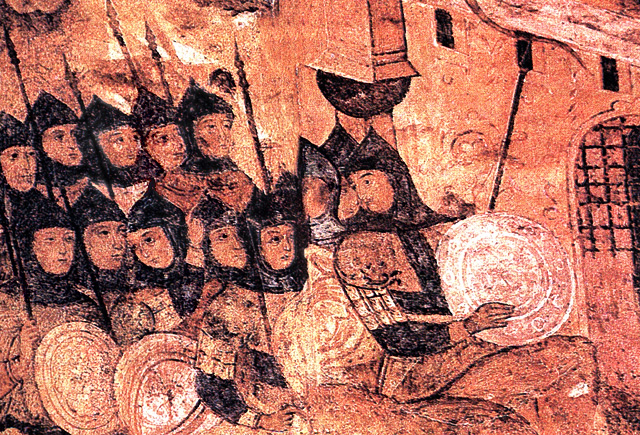
Rus' under the walls of Constantinople (860)
Between 850 and 1100, the Empire developed a mixed relationship with the new state of the Kievan Rus', which had emerged to the north across the Black Sea.[102] This relationship would have long-lasting repercussions in the history of the East Slavs, and the Empire quickly became the main trading and cultural partner for Kiev. The Rus' launched their first attack against Constantinople in 860, pillaging the suburbs of the city. In 941, they appeared on the Asian shore of the Bosphorus, but this time they were crushed, an indication of the improvements in the Byzantine military position after 907, when only diplomacy had been able to push back the invaders. Basil II could not ignore the emerging power of the Rus', and, following the example of his predecessors, he used religion as a means for the achievement of political purposes.[103] Rus'–Byzantine relations became closer following the marriage of Anna Porphyrogeneta to Vladimir the Great in 988, and the subsequent Christianisation of the Rus'.[102] Byzantine priests, architects, and artists were invited to work on numerous cathedrals and churches around Rus', expanding Byzantine cultural influence even further, while numerous Rus' served in the Byzantine army as mercenaries, most notably as the famous Varangian Guard.[102]
Even after the Christianisation of the Rus', however, relations were not always friendly. The most serious conflict between the two powers was the war of 968–971 in Bulgaria, but several Rus' raiding expeditions against the Byzantine cities of the Black Sea coast and Constantinople itself are also recorded. Although most were repulsed, they were often followed by treaties that were generally favourable to the Rus', such as the one concluded at the end of the war of 1043, during which the Rus' gave an indication of their ambitions to compete with the Byzantines as an independent power.[103]
Campaigns in the Caucasus
Between 1021 and 1022, following years of tensions, Basil II led a series of victorious campaigns against the Kingdom of Georgia, resulting in the annexation of several Georgian provinces to the Empire. Basil's successors also annexed Bagratid Armenia in 1045. Importantly, both Georgia and Armenia were significantly weakened by the Byzantine administration's policy of heavy taxation and abolishing of the levy. The weakening of Georgia and Armenia would play a significant role in the Byzantine defeat at Manzikert in 1071.[104]
Apex
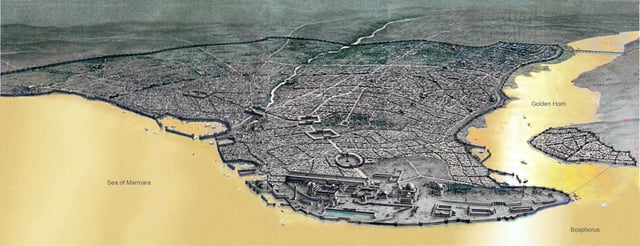
Constantinople was the largest and wealthiest city in Europe throughout the Late antiquity and almost the whole Middle Ages until the Fourth Crusade in 1204
Basil II is considered among the most capable Byzantine emperors and his reign as the apex of the empire in the Middle Ages. By 1025, the date of Basil II's death, the Byzantine Empire stretched from Armenia in the east to Calabria in Southern Italy in the west.[95] Many successes had been achieved, ranging from the conquest of Bulgaria to the annexation of parts of Georgia and Armenia, and the reconquest of Crete, Cyprus, and the important city of Antioch. These were not temporary tactical gains but long-term reconquests.[88]
Leo VI achieved the complete codification of Byzantine law in Greek. This monumental work of 60 volumes became the foundation of all subsequent Byzantine law and is still studied today.[105] Leo also reformed the administration of the Empire, redrawing the borders of the administrative subdivisions (the Themata, or "Themes") and tidying up the system of ranks and privileges, as well as regulating the behaviour of the various trade guilds in Constantinople. Leo's reform did much to reduce the previous fragmentation of the Empire, which henceforth had one center of power, Constantinople.[106] However, the increasing military success of the Empire greatly enriched and empowered the provincial nobility with respect to the peasantry, who were essentially reduced to a state of serfdom.[107]
Under the Macedonian emperors, the city of Constantinople flourished, becoming the largest and wealthiest city in Europe, with a population of approximately 400,000 in the 9th and 10th centuries.[108] During this period, the Byzantine Empire employed a strong civil service staffed by competent aristocrats that oversaw the collection of taxes, domestic administration, and foreign policy. The Macedonian emperors also increased the Empire's wealth by fostering trade with Western Europe, particularly through the sale of silk and metalwork.[109]
Split between Orthodoxy and Catholicism (1054)

Mural of Saints Cyril and Methodius, 19th century, Troyan Monastery, Bulgaria
The Macedonian period also included events of momentous religious significance. The conversion of the Bulgarians, Serbs and Rus' to Orthodox Christianity drew the religious map of Europe which still resonates today. Cyril and Methodius, two Byzantine Greek brothers from Thessaloniki, contributed significantly to the Christianization of the Slavs and in the process devised the Glagolitic alphabet, ancestor to the Cyrillic script.[110]
In 1054, relations between the Eastern and Western traditions of the Chalcedonian Christian Church reached a terminal crisis, known as the East–West Schism. Although there was a formal declaration of institutional separation, on 16 July, when three papal legates entered the Hagia Sophia during Divine Liturgy on a Saturday afternoon and placed a bull of excommunication on the altar,[111] the so-called Great Schism was actually the culmination of centuries of gradual separation.[112]
Crisis and fragmentation

The seizure of Edessa (1031) by the Byzantines under George Maniakes and the counterattack by the Seljuk Turks
The Byzantine Empire soon fell into a period of difficulties, caused to a large extent by the undermining of the theme system and the neglect of the military. Nikephoros II, John Tzimiskes, and Basil II shifted the emphasis of the military divisions (τάγματα, tagmata) from a reactive, defence-oriented citizen army into an army of professional career soldiers, increasingly dependent on foreign mercenaries. Mercenaries were expensive, however, and as the threat of invasion receded in the 10th century, so did the need for maintaining large garrisons and expensive fortifications.[113] Basil II left a burgeoning treasury upon his death, but he neglected to plan for his succession. None of his immediate successors had any particular military or political talent and the imperial administration increasingly fell into the hands of the civil service. Incompetent efforts to revive the Byzantine economy resulted in severe inflation and a debased gold currency. The army was now seen as both an unnecessary expense and a political threat. A number of standing local units were demobilised, further augmenting the army's dependence on mercenaries, who could be retained and dismissed on an as-needed basis.[114]
At the same time, Byzantium was faced with new enemies. Its provinces in southern Italy were threatened by the Normans, who arrived in Italy at the beginning of the 11th century. During a period of strife between Constantinople and Rome culminating in the East-West Schism of 1054, the Normans began to advance, slowly but steadily, into Byzantine Italy.[115] Reggio, the capital of the tagma of Calabria, was captured in 1060 by Robert Guiscard, followed by Otranto in 1068. Bari, the main Byzantine stronghold in Apulia, was besieged in August 1068 and fell in April 1071.[116]
In 1048-9, the Seljuk Turks under Ibrahim Yinal made their first incursion into the Byzantine frontier region of Iberia and defeated a combined Byzantine-Georgian army of 50,000 at the Battle of Kapetrou on 10 September 1048. The Arab chronicler Ibn al-Athir reports that Ibrahim brought back 100,000 captives and a vast booty loaded on the backs of ten thousand camels.[117]
About 1053 Constantine IX disbanded what the historian John Skylitzes calls the "Iberian Army", which consisted of 50,000 men and it was turned into a contemporary Drungary of the Watch. Two other knowledgeable contemporaries, the former officials Michael Attaleiates and Kekaumenos, agree with Skylitzes that by demobilising these soldiers Constantine did catastrophic harm to the Empire's eastern defences.
The emergency lent weight to the military aristocracy in Anatolia, who in 1068 secured the election of one of their own, Romanos Diogenes, as emperor. In the summer of 1071, Romanos undertook a massive eastern campaign to draw the Seljuks into a general engagement with the Byzantine army. At the Battle of Manzikert, Romanos suffered a surprise defeat by Sultan Alp Arslan, and he was captured. Alp Arslan treated him with respect and imposed no harsh terms on the Byzantines.[114] In Constantinople, however, a coup put in power Michael Doukas, who soon faced the opposition of Nikephoros Bryennios and Nikephoros Botaneiates. By 1081, the Seljuks had expanded their rule over virtually the entire Anatolian plateau from Armenia in the east to Bithynia in the west, and they had founded their capital at Nicaea, just 90 kilometres (56 miles) from Constantinople.[118]
Komnenian dynasty and the Crusades
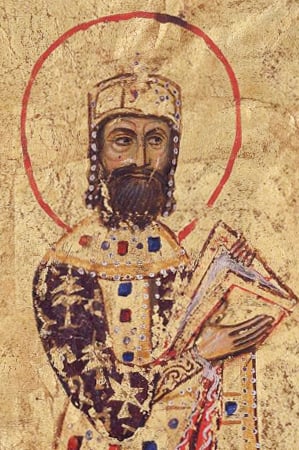
Alexios I, founder of the Komnenos dynasty
During the Komnenian, or Comnenian, period from about 1081 to about 1185, the five emperors of the Komnenos dynasty (Alexios I, John II, Manuel I, Alexios II, and Andronikos I) presided over a sustained, though ultimately incomplete, restoration of the military, territorial, economic, and political position of the Byzantine Empire.[119] Although the Seljuk Turks occupied the heartland of the Empire in Anatolia, most Byzantine military efforts during this period were directed against Western powers, particularly the Normans.[119]
The Empire under the Komnenoi played a key role in the history of the Crusades in the Holy Land, which Alexios I had helped bring about, while also exerting enormous cultural and political influence in Europe, the Near East, and the lands around the Mediterranean Sea under John and Manuel. Contact between Byzantium and the "Latin" West, including the Crusader states, increased significantly during the Komnenian period. Venetian and other Italian traders became resident in large numbers in Constantinople and the empire (there were an estimated 60,000 Latins in Constantinople alone, out of a population of three to four hundred thousand), and their presence together with the numerous Latin mercenaries who were employed by Manuel helped to spread Byzantine technology, art, literature and culture throughout the Latin West, while also leading to a flow of Western ideas and customs into the Empire.[120]
In terms of prosperity and cultural life, the Komnenian period was one of the peaks in Byzantine history,[121] and Constantinople remained the leading city of the Christian world in size, wealth, and culture.[122] There was a renewed interest in classical Greek philosophy, as well as an increase in literary output in vernacular Greek.[123] Byzantine art and literature held a pre-eminent place in Europe, and the cultural impact of Byzantine art on the west during this period was enormous and of long lasting significance.[124]
Alexios I and the First Crusade

Province (theme) of the Byzantine Empire c. 1045
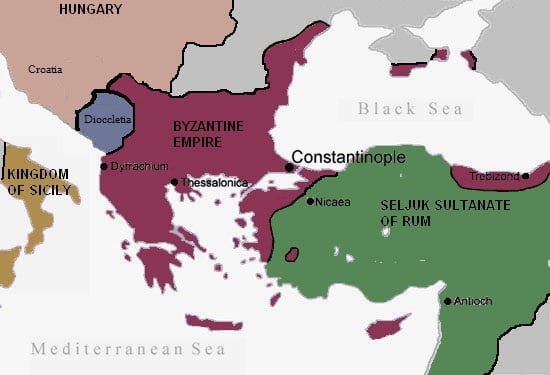
The Byzantine Empire and the Seljuk Sultanate of Rûm before the First Crusade (1095–1099)
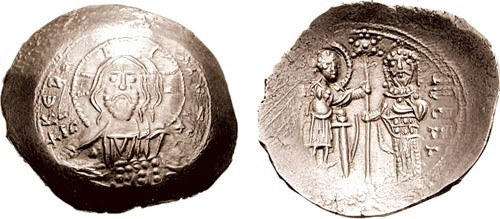
The brief first coinage of the Thessaloniki mint, opened by Alexios in September 1081, on his way to confront the invading Normans under Robert Guiscard
After Manzikert, a partial recovery (referred to as the Komnenian restoration) was made possible by the Komnenian dynasty.[125] The Komnenoi attained power again under Alexios I in 1081. From the outset of his reign, Alexios faced a formidable attack by the Normans under Robert Guiscard and his son Bohemund of Taranto, who captured Dyrrhachium and Corfu, and laid siege to Larissa in Thessaly. Robert Guiscard's death in 1085 temporarily eased the Norman problem. The following year, the Seljuq sultan died, and the sultanate was split by internal rivalries. By his own efforts, Alexios defeated the Pechenegs; they were caught by surprise and annihilated at the Battle of Levounion on 28 April 1091.[126]
Having achieved stability in the West, Alexios could turn his attention to the severe economic difficulties and the disintegration of the Empire's traditional defences.[127] However, he still did not have enough manpower to recover the lost territories in Asia Minor and to advance against the Seljuks. At the Council of Piacenza in 1095, envoys from Alexios spoke to Pope Urban II about the suffering of the Christians of the East, and underscored that without help from the West they would continue to suffer under Muslim rule.[128]
Urban saw Alexios's request as a dual opportunity to cement Western Europe and reunite the Eastern Orthodox Church with the Roman Catholic Church under his rule.[128] On 27 November 1095, Pope Urban II called together the Council of Clermont, and urged all those present to take up arms under the sign of the Cross and launch an armed pilgrimage to recover Jerusalem and the East from the Muslims. The response in Western Europe was overwhelming.[126]
Alexios had anticipated help in the form of mercenary forces from the West, but he was totally unprepared for the immense and undisciplined force that soon arrived in Byzantine territory. It was no comfort to Alexios to learn that four of the eight leaders of the main body of the Crusade were Normans, among them Bohemund. Since the crusade had to pass through Constantinople, however, the Emperor had some control over it. He required its leaders to swear to restore to the empire any towns or territories they might reconquer from the Turks on their way to the Holy Land. In return, he gave them guides and a military escort.[129]
Alexios was able to recover a number of important cities and islands, and in fact much of western Asia Minor. The Crusaders agreed to become Alexios' vassals under the Treaty of Devol in 1108, which marked the end of the Norman threat during Alexios' reign.[130]
John II, Manuel I and the Second Crusade
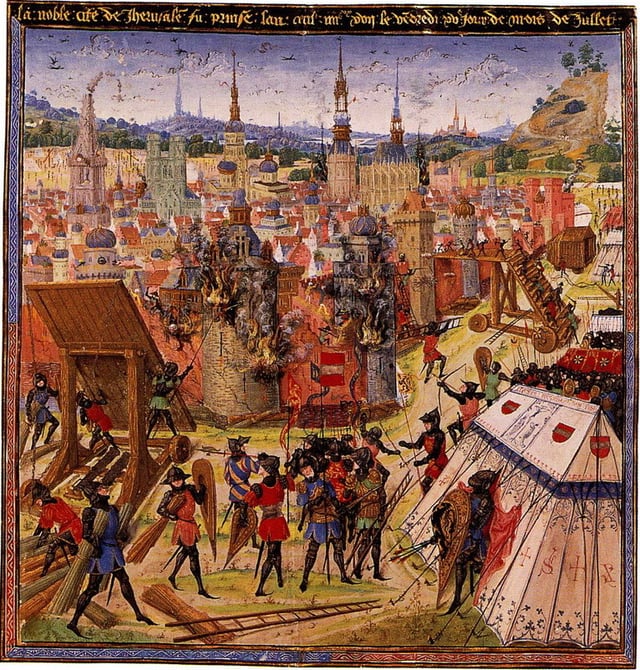
Medieval manuscript depicting the Capture of Jerusalem during the First Crusade

Byzantine Empire in orange, c. 1180, at the end of the Komnenian period
Alexios's son John II Komnenos succeeded him in 1118 and ruled until 1143. John was a pious and dedicated Emperor who was determined to undo the damage to the empire suffered at the Battle of Manzikert, half a century earlier.[131] Famed for his piety and his remarkably mild and just reign, John was an exceptional example of a moral ruler at a time when cruelty was the norm.[132] For this reason, he has been called the Byzantine Marcus Aurelius.
During his twenty-five-year reign, John made alliances with the Holy Roman Empire in the West and decisively defeated the Pechenegs at the Battle of Beroia.[133] He thwarted Hungarian and Serbian threats during the 1120s, and in 1130 he allied himself with the German emperor Lothair III against the Norman king Roger II of Sicily.[134]
In the later part of his reign, John focused his activities on the East, personally leading numerous campaigns against the Turks in Asia Minor. His campaigns fundamentally altered the balance of power in the East, forcing the Turks onto the defensive, while restoring many towns, fortresses, and cities across the peninsula to the Byzantines. He defeated the Danishmend Emirate of Melitene and reconquered all of Cilicia, while forcing Raymond of Poitiers, Prince of Antioch, to recognise Byzantine suzerainty. In an effort to demonstrate the Emperor's role as the leader of the Christian world, John marched into the Holy Land at the head of the combined forces of the Empire and the Crusader states; yet despite his great vigour pressing the campaign, his hopes were disappointed by the treachery of his Crusader allies.[135] In 1142, John returned to press his claims to Antioch, but he died in the spring of 1143 following a hunting accident.
John's chosen heir was his fourth son, Manuel I Komnenos, who campaigned aggressively against his neighbours both in the west and in the east. In Palestine, Manuel allied with the Crusader Kingdom of Jerusalem and sent a large fleet to participate in a combined invasion of Fatimid Egypt. Manuel reinforced his position as overlord of the Crusader states, with his hegemony over Antioch and Jerusalem secured by agreement with Raynald, Prince of Antioch, and Amalric, King of Jerusalem.[136] In an effort to restore Byzantine control over the ports of southern Italy, he sent an expedition to Italy in 1155, but disputes within the coalition led to the eventual failure of the campaign. Despite this military setback, Manuel's armies successfully invaded the Southern parts of the Kingdom of Hungary in 1167, defeating the Hungarians at the Battle of Sirmium. By 1168, nearly the whole of the eastern Adriatic coast lay in Manuel's hands.[137] Manuel made several alliances with the Pope and Western Christian kingdoms, and he successfully handled the passage of the Second Crusade through his empire.[138]
In the east, however, Manuel suffered a major defeat in 1176 at the Battle of Myriokephalon, against the Turks. Yet the losses were quickly recovered, and in the following year Manuel's forces inflicted a defeat upon a force of "picked Turks".[139] The Byzantine commander John Vatatzes, who destroyed the Turkish invaders at the Battle of Hyelion and Leimocheir, not only brought troops from the capital but also was able to gather an army along the way, a sign that the Byzantine army remained strong and that the defensive program of western Asia Minor was still successful.[140]
12th-century Renaissance
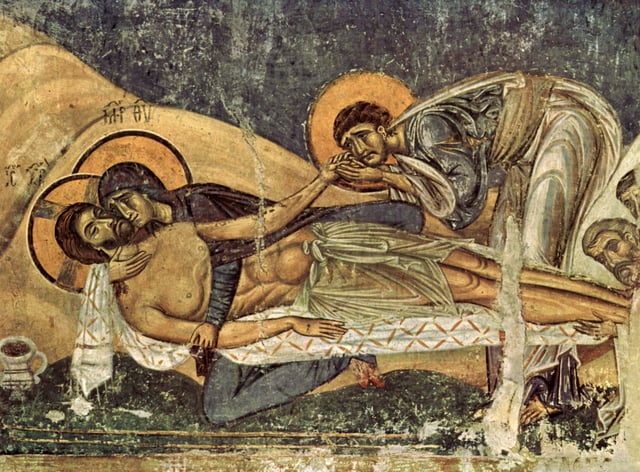
The Lamentation of Christ (1164), a fresco from the church of Saint Panteleimon in Nerezi, North Macedonia, considered a superb example of 12th-century Komnenian art
John and Manuel pursued active military policies, and both deployed considerable resources on sieges and on city defences; aggressive fortification policies were at the heart of their imperial military policies.[141] Despite the defeat at Myriokephalon, the policies of Alexios, John and Manuel resulted in vast territorial gains, increased frontier stability in Asia Minor, and secured the stabilisation of the Empire's European frontiers. From c. 1081 to c. 1180, the Komnenian army assured the Empire's security, enabling Byzantine civilisation to flourish.[142]
This allowed the Western provinces to achieve an economic revival that continued until the close of the century. It has been argued that Byzantium under the Komnenian rule was more prosperous than at any time since the Persian invasions of the 7th century. During the 12th century, population levels rose and extensive tracts of new agricultural land were brought into production. Archaeological evidence from both Europe and Asia Minor shows a considerable increase in the size of urban settlements, together with a notable upsurge in new towns. Trade was also flourishing; the Venetians, the Genoese and others opened up the ports of the Aegean to commerce, shipping goods from the Crusader kingdoms of Outremer and Fatimid Egypt to the west and trading with the Empire via Constantinople.[143]
In artistic terms, there was a revival in mosaic, and regional schools of architecture began producing many distinctive styles that drew on a range of cultural influences.[144] During the 12th century, the Byzantines provided their model of early humanism as a renaissance of interest in classical authors. In Eustathius of Thessalonica, Byzantine humanism found its most characteristic expression.[145] In philosophy, there was resurgence of classical learning not seen since the 7th century, characterised by a significant increase in the publication of commentaries on classical works.[123] In addition, the first transmission of classical Greek knowledge to the West occurred during the Komnenian period.[124]
Decline and disintegration
Angelid dynasty
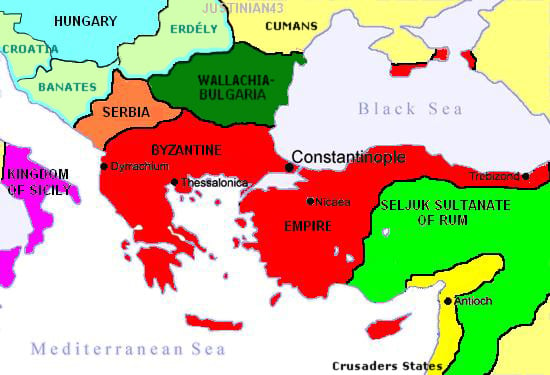
Byzantium in the late Angeloi period
Manuel's death on 24 September 1180 left his 11-year-old son Alexios II Komnenos on the throne. Alexios was highly incompetent in the office, and with his mother Maria of Antioch's Frankish background, made his regency unpopular.[146] Eventually, Andronikos I Komnenos, a grandson of Alexios I, launched a revolt against his younger relative and managed to overthrow him in a violent coup d'état.[147] Utilizing his good looks and his immense popularity with the army, he marched on to Constantinople in August 1182 and incited a massacre of the Latins.[147] After eliminating his potential rivals, he had himself crowned as co-emperor in September 1183. He eliminated Alexios II, and took his 12-year-old wife Agnes of France for himself.[147]
Andronikos began his reign well; in particular, the measures he took to reform the government of the Empire have been praised by historians. According to George Ostrogorsky, Andronikos was determined to root out corruption: Under his rule, the sale of offices ceased; selection was based on merit, rather than favouritism; officials were paid an adequate salary so as to reduce the temptation of bribery. In the provinces, Andronikos's reforms produced a speedy and marked improvement.[148] The aristocrats were infuriated against him, and to make matters worse, Andronikos seems to have become increasingly unbalanced; executions and violence became increasingly common, and his reign turned into a reign of terror.[149] Andronikos seemed almost to seek the extermination of the aristocracy as a whole. The struggle against the aristocracy turned into wholesale slaughter, while the Emperor resorted to ever more ruthless measures to shore up his regime.[148]
Despite his military background, Andronikos failed to deal with Isaac Komnenos, Béla III of Hungary (r. 1172–1196) who reincorporated Croatian territories into Hungary, and Stephen Nemanja of Serbia (r. 1166–1196) who declared his independence from the Byzantine Empire. Yet, none of these troubles would compare to William II of Sicily's (r. 1166–1189) invasion force of 300 ships and 80,000 men, arriving in 1185.[150] Andronikos mobilised a small fleet of 100 ships to defend the capital, but other than that he was indifferent to the populace. He was finally overthrown when Isaac Angelos, surviving an imperial assassination attempt, seized power with the aid of the people and had Andronikos killed.[151]
The reign of Isaac II, and more so that of his brother Alexios III, saw the collapse of what remained of the centralised machinery of Byzantine government and defence. Although the Normans were driven out of Greece, in 1186 the Vlachs and Bulgars began a rebellion that led to the formation of the Second Bulgarian Empire. The internal policy of the Angeloi was characterised by the squandering of the public treasure and fiscal maladministration. Imperial authority was severely weakened, and the growing power vacuum at the center of the Empire encouraged fragmentation. There is evidence that some Komnenian heirs had set up a semi-independent state in Trebizond before 1204.[152] According to Alexander Vasiliev, "the dynasty of the Angeloi, Greek in its origin, ... accelerated the ruin of the Empire, already weakened without and disunited within."[153]
Fourth Crusade
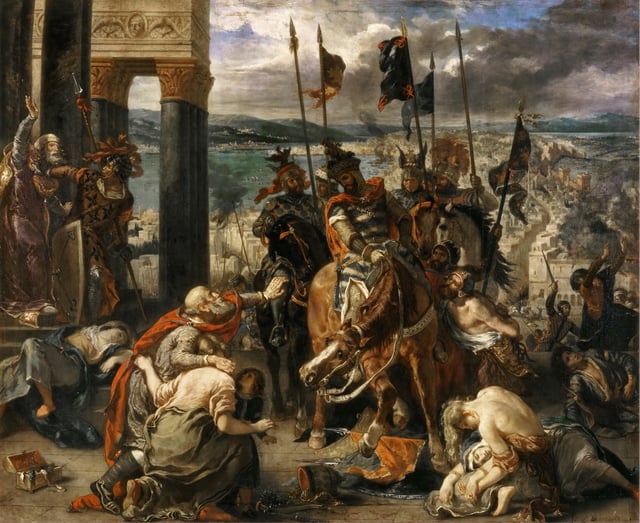
The Entry of the Crusaders into Constantinople, by Eugène Delacroix (1840)
In 1198, Pope Innocent III broached the subject of a new crusade through legates and encyclical letters.[154] The stated intent of the crusade was to conquer Egypt, now the centre of Muslim power in the Levant. The crusader army that arrived at Venice in the summer of 1202 and hired the Venetian fleet to transport them to Egypt. As payment to the Venetians, they captured the (Christian) port of Zara in Dalmatia (vassal city of Venice, which had rebelled and placed itself under Hungary's protection in 1186).[155] Shortly afterwards, Alexios Angelos, son of the deposed and blinded Emperor Isaac II Angelos, made contacts with the crusaders. Alexios offered to reunite the Byzantine church with Rome, pay the crusaders 200,000 silver marks, join the crusade and provide all the supplies they needed to get to Egypt.[156]
Crusader sack of Constantinople (1204)
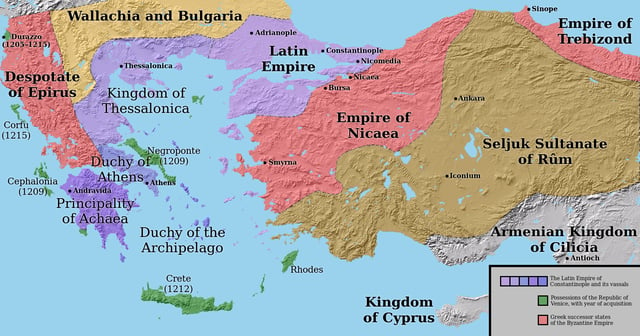
The partition of the empire following the Fourth Crusade, c. 1204
The crusaders arrived at Constantinople in the summer of 1203 and quickly attacked, starting a major fire that damaged large parts of the city, and briefly seized control. Alexios III fled from the capital and Alexios Angelos was elevated to the throne as Alexios IV along with his blind father Isaac. Alexios IV and Isaac II were unable to keep their promises and were deposed by Alexios V. The crusaders again took the city on 13 April 1204 and Constantinople was subjected to pillage and massacre by the rank and file for three days. Many priceless icons, relics and other objects later turned up in Western Europe, a large number in Venice. According to Choniates, a prostitute was even set up on the Patriarchal throne.[157] When order had been restored, the crusaders and the Venetians proceeded to implement their agreement; Baldwin of Flanders was elected Emperor of a new Latin Empire and the Venetian Thomas Morosini was chosen as Patriarch. The lands divided up among the leaders included most of the former Byzantine possessions, though resistance would continue through the Byzantine remnants of Nicaea, Trebizond, and Epirus. [157] Although Venice was more interested in commerce than conquering territory, it took key areas of Constantinople and the Doge took the title of "Lord of a Quarter and Half a Quarter of the Roman Empire".[159]
Fall
Empire in exile
After the sack of Constantinople in 1204 by Latin crusaders, two Byzantine successor states were established: the Empire of Nicaea, and the Despotate of Epirus. A third, the Empire of Trebizond, was created after Alexios Komnenos, commanding the Georgian expedition in Chaldia[160] a few weeks before the sack of Constantinople, found himself de facto emperor, and established himself in Trebizond. Of the three successor states, Epirus and Nicaea stood the best chance of reclaiming Constantinople. The Nicaean Empire struggled to survive the next few decades, however, and by the mid-13th century it had lost much of southern Anatolia.[161] The weakening of the Sultanate of Rûm following the Mongol invasion in 1242–43 allowed many beyliks and ghazis to set up their own principalities in Anatolia, weakening the Byzantine hold on Asia Minor.[162] In time, one of the Beys, Osman I, created an empire that would eventually conquer Constantinople. However, the Mongol invasion also gave Nicaea a temporary respite from Seljuk attacks, allowing it to concentrate on the Latin Empire to its north.
Reconquest of Constantinople

The Byzantine Empire, c. 1263
The Empire of Nicaea, founded by the Laskarid dynasty, managed to effect the Recapture of Constantinople from the Latins in 1261 and defeat Epirus. This led to a short-lived revival of Byzantine fortunes under Michael VIII Palaiologos but the war-ravaged Empire was ill-equipped to deal with the enemies that surrounded it. To maintain his campaigns against the Latins, Michael pulled troops from Asia Minor and levied crippling taxes on the peasantry, causing much resentment.[163] Massive construction projects were completed in Constantinople to repair the damage of the Fourth Crusade but none of these initiatives was of any comfort to the farmers in Asia Minor suffering raids from Muslim ghazis.[164]
Rather than holding on to his possessions in Asia Minor, Michael chose to expand the Empire, gaining only short-term success. To avoid another sacking of the capital by the Latins, he forced the Church to submit to Rome, again a temporary solution for which the peasantry hated Michael and Constantinople.[164] The efforts of Andronikos II and later his grandson Andronikos III marked Byzantium's last genuine attempts in restoring the glory of the Empire. However, the use of mercenaries by Andronikos II would often backfire, with the Catalan Company ravaging the countryside and increasing resentment towards Constantinople.[165]
Rise of the Ottomans and fall of Constantinople
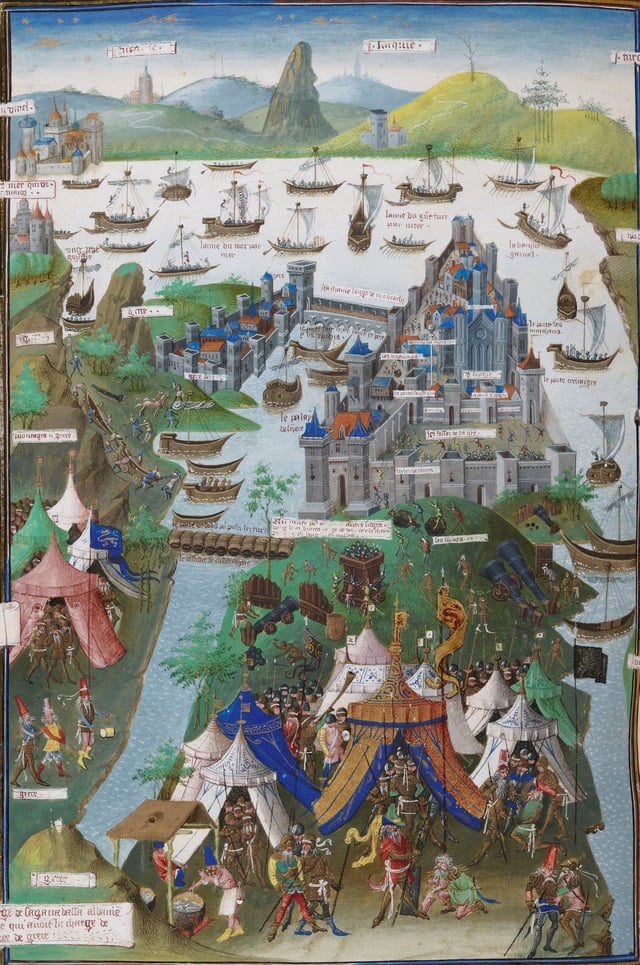
The siege of Constantinople in 1453, depicted in a 15th-century French miniature
The situation became worse for Byzantium during the civil wars after Andronikos III died. A six-year-long civil war devastated the empire, allowing the Serbian ruler Stefan Dušan (r. 1331–1346) to overrun most of the Empire's remaining territory and establish a Serbian Empire. In 1354, an earthquake at Gallipoli devastated the fort, allowing the Ottomans (who were hired as mercenaries during the civil war by John VI Kantakouzenos) to establish themselves in Europe.[166] By the time the Byzantine civil wars had ended, the Ottomans had defeated the Serbians and subjugated them as vassals. Following the Battle of Kosovo, much of the Balkans became dominated by the Ottomans.[167]
The Byzantine emperors appealed to the West for help, but the Pope would only consider sending aid in return for a reunion of the Eastern Orthodox Church with the See of Rome. Church unity was considered, and occasionally accomplished by imperial decree, but the Orthodox citizenry and clergy intensely resented the authority of Rome and the Latin Rite.[168] Some Western troops arrived to bolster the Christian defence of Constantinople, but most Western rulers, distracted by their own affairs, did nothing as the Ottomans picked apart the remaining Byzantine territories.[169]
Constantinople by this stage was underpopulated and dilapidated. The population of the city had collapsed so severely that it was now little more than a cluster of villages separated by fields. On 2 April 1453, Sultan Mehmed's army of 80,000 men and large numbers of irregulars laid siege to the city.[170] Despite a desperate last-ditch defence of the city by the massively outnumbered Christian forces (c. 7,000 men, 2,000 of whom were foreign),[169] Constantinople finally fell to the Ottomans after a two-month siege on 29 May 1453. The last Byzantine emperor, Constantine XI Palaiologos, was last seen casting off his imperial regalia and throwing himself into hand-to-hand combat after the walls of the city were taken.[171]
Political aftermath

The Eastern Mediterranean just before the fall of Constantinople

Flag of the late Empire under the Palaiologoi, sporting the tetragrammic cross symbol of the Palaiologos dynasty
By the time of the fall of Constantinople, the only remaining territory of the Byzantine Empire was the Despotate of the Morea (Peloponnese), which was ruled by brothers of the last Emperor, Thomas Palaiologos and Demetrios Palaiologos. The Despotate continued on as an independent state by paying an annual tribute to the Ottomans. Incompetent rule, failure to pay the annual tribute and a revolt against the Ottomans finally led to Mehmed II's invasion of Morea in May 1460.
A few holdouts remained for a time. The island of Monemvasia refused to surrender and it was first ruled for a short time by an Aragonese corsair. When the population drove him out they obtained the consent of Thomas to place themselves under the Pope's protection before the end of 1460. The Mani Peninsula, on the Morea's south end, resisted under a loose coalition of the local clans and then that area came under Venice's rule. The very last holdout was Salmeniko, in the Morea's northwest. Graitzas Palaiologos was the military commander there, stationed at Salmeniko Castle. While the town eventually surrendered, Graitzas and his garrison and some town residents held out in the castle until July 1461, when they escaped and reached Venetian territory.[172]
The Empire of Trebizond, which had split away from the Byzantine Empire just weeks before Constantinople was taken by the Crusaders in 1204, became the last remnant and last de facto successor state to the Byzantine Empire. Efforts by the Emperor David to recruit European powers for an anti-Ottoman crusade provoked war between the Ottomans and Trebizond in the summer of 1461. After a month-long siege, David surrendered the city of Trebizond on 14 August 1461. The Empire of Trebizond's Crimean principality, the Principality of Theodoro (part of the Perateia), lasted another 14 years, falling to the Ottomans in December 1475.
A nephew of the last Emperor, Constantine XI, Andreas Palaiologos claimed to have inherited the title of Byzantine Emperor. He lived in the Morea until its fall in 1460, then escaped to Rome where he lived under the protection of the Papal States for the remainder of his life. Since the office of emperor had never been technically hereditary, Andreas' claim would have been without merit under Byzantine law. However, the Empire had vanished, and Western states generally followed the Roman-church-sanctioned principles of hereditary sovereignty. Seeking a life in the west, Andreas styled himself Imperator Constantinopolitanus ("Emperor of Constantinople"), and sold his succession rights to both Charles VIII of France and the Catholic Monarchs.
Constantine XI died without producing an heir, and had Constantinople not fallen he might have been succeeded by the sons of his deceased elder brother, who were taken into the palace service of Mehmed II after the fall of Constantinople. The oldest boy, renamed Has Murad, became a personal favourite of Mehmed and served as Beylerbey (Governor-General) of the Balkans. The younger son, renamed Mesih Pasha, became Admiral of the Ottoman fleet and Sancak Beg (Governor) of the Province of Gallipoli. He eventually served twice as Grand Vizier under Mehmed's son, Bayezid II.[173]
Mehmed II and his successors continued to consider themselves heirs to the Roman Empire until the demise of the Ottoman Empire in the early 20th century following World War 1. They considered that they had simply shifted its religious basis as Constantine had done before, and they continued to refer to their conquered Eastern Roman inhabitants (Orthodox Christians) as Rûm. Meanwhile, the Danubian Principalities (whose rulers also considered themselves the heirs of the Eastern Roman Emperors[174]) harboured Orthodox refugees, including some Byzantine nobles.
At his death, the role of the emperor as a patron of Eastern Orthodoxy was claimed by Ivan III, Grand duke of Muscovy. He had married Andreas' sister, Sophia Palaiologina, whose grandson, Ivan IV, would become the first Tsar of Russia (tsar, or czar, meaning caesar, is a term traditionally applied by Slavs to the Byzantine Emperors). Their successors supported the idea that Moscow was the proper heir to Rome and Constantinople. The idea of the Russian Empire as the successive Third Rome was kept alive until its demise with the Russian Revolution.[175]
Government and bureaucracy

The themes, c. 950

The themes, c. 750
In the Byzantine state, the emperor was the sole and absolute ruler, and his power was regarded as having divine origin.[176] The Senate had ceased to have real political and legislative authority but remained as an honorary council with titular members. By the end of the 8th century, a civil administration focused on the court was formed as part of a large-scale consolidation of power in the capital (the rise to pre-eminence of the position of sakellarios is related to this change).[177] The most important administrative reform, which probably started in the mid-7th century, was the creation of themes, where civil and military administration was exercised by one person, the strategos.[178]
Despite the occasionally derogatory use of the terms "Byzantine" and "Byzantinism", the Byzantine bureaucracy had a distinct ability for reconstituting itself in accordance with the Empire's situation. The elaborate system of titulature and precedence gave the court prestige and influence. Officials were arranged in strict order around the emperor, and depended upon the imperial will for their ranks. There were also actual administrative jobs, but authority could be vested in individuals rather than offices.[179]
In the 8th and 9th centuries, civil service constituted the clearest path to aristocratic status, but, starting in the 9th century, the civil aristocracy was rivalled by an aristocracy of nobility. According to some studies of Byzantine government, 11th-century politics were dominated by competition between the civil and the military aristocracy. During this period, Alexios I undertook important administrative reforms, including the creation of new courtly dignities and offices.[180]
Diplomacy
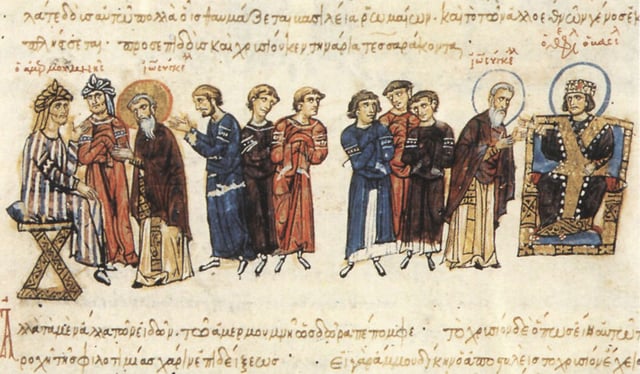
The embassy of John the Grammarian in 829, between the emperor Theophilos and the Abbasid caliph Al-Ma'mun
After the fall of Rome, the key challenge to the Empire was to maintain a set of relations between itself and its neighbours. When these nations set about forging formal political institutions, they often modelled themselves on Constantinople. Byzantine diplomacy soon managed to draw its neighbours into a network of international and inter-state relations.[181] This network revolved around treaty making, and included the welcoming of the new ruler into the family of kings, and the assimilation of Byzantine social attitudes, values and institutions.[182] Whereas classical writers are fond of making ethical and legal distinctions between peace and war, Byzantines regarded diplomacy as a form of war by other means. For example, a Bulgarian threat could be countered by providing money to the Kievan Rus'.[183]
Diplomacy in the era was understood to have an intelligence-gathering function on top of its pure political function. The Bureau of Barbarians in Constantinople handled matters of protocol and record keeping for any issues related to the "barbarians", and thus had, perhaps, a basic intelligence function itself.[184] John B. Bury believed that the office exercised supervision over all foreigners visiting Constantinople, and that they were under the supervision of the Logothetes tou dromou.[185] While on the surface a protocol office – its main duty was to ensure foreign envoys were properly cared for and received sufficient state funds for their maintenance, and it kept all the official translators – it probably had a security function as well.[186]
Byzantines availed themselves of a number of diplomatic practices. For example, embassies to the capital would often stay on for years. A member of other royal houses would routinely be requested to stay on in Constantinople, not only as a potential hostage, but also as a useful pawn in case political conditions where he came from changed. Another key practice was to overwhelm visitors by sumptuous displays.[181] According to Dimitri Obolensky, the preservation of the ancient civilisation in Europe was due to the skill and resourcefulness of Byzantine diplomacy, which remains one of Byzantium's lasting contributions to the history of Europe.[187]
Science, medicine and law
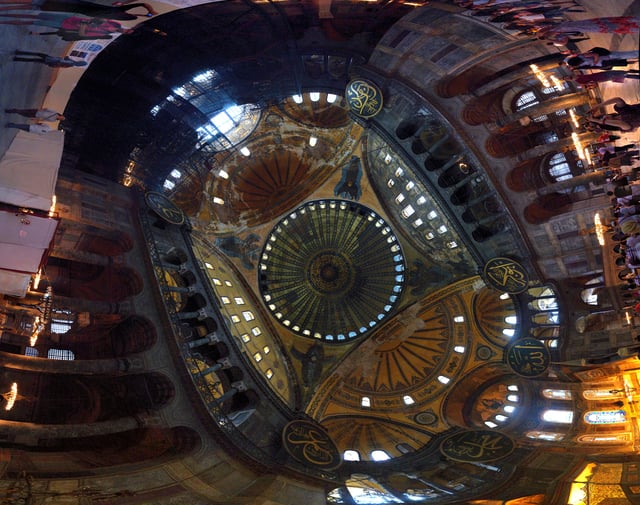
Interior panorama of the Hagia Sophia, the patriarchal basilica in Constantinople designed 537 CE by Isidore of Miletus, the first compiler of Archimedes' various works. The influence of Archimedes' principles of solid geometry is evident.
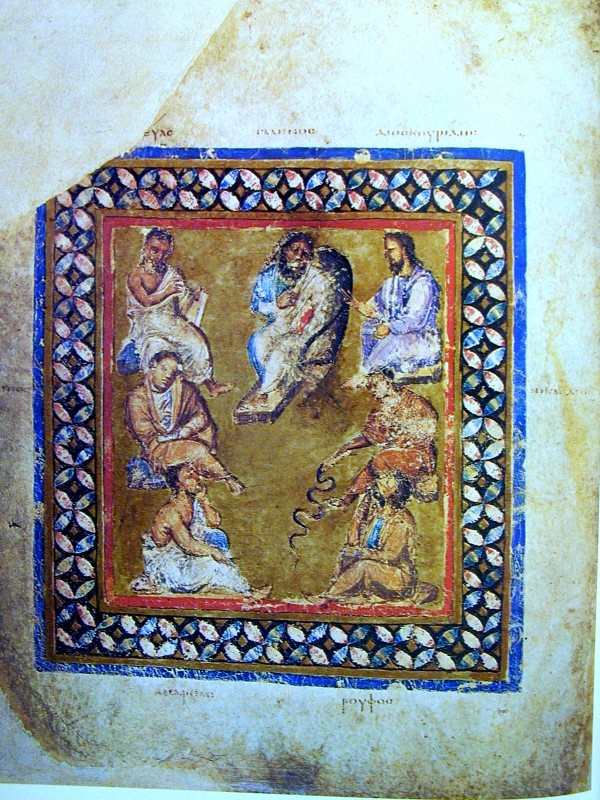
The frontispiece of the Vienna Dioscurides, which shows a set of seven famous physicians
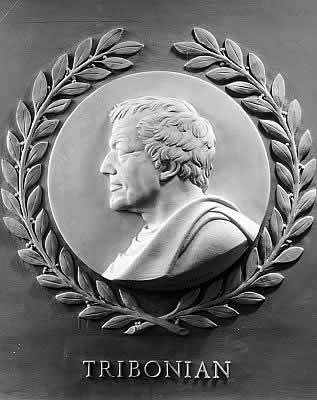
Bas-relief plaque of Tribonian in the Chamber of the House of Representatives in the United States Capitol.
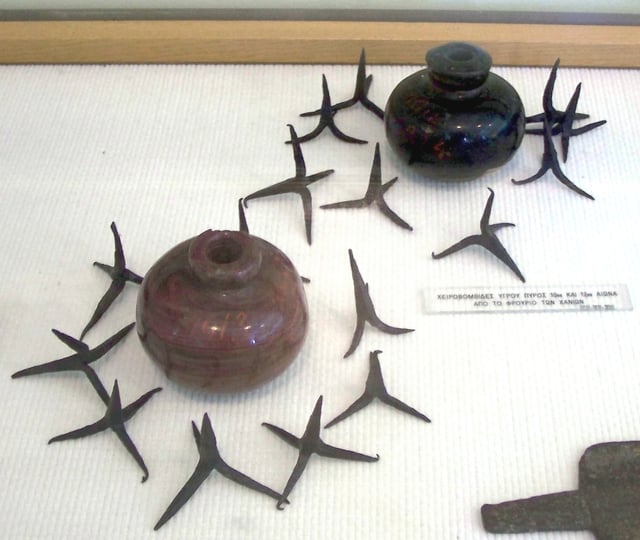
Ceramic grenades that were filled with Greek fire, surrounded by caltrops, 10th–12th century, National Historical Museum, Athens, Greece
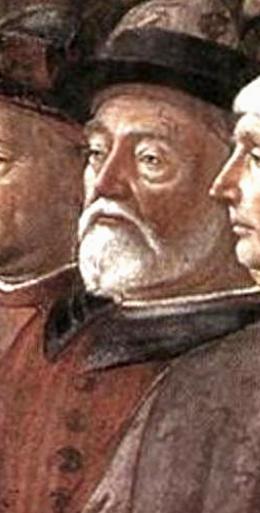
Many refugee Byzantine scholars fled to North Italy in the 1400s. Here John Argyropoulos (1415–1487), born in Constantinople and who ended his days in north Italy.
The writings of Classical antiquity were cultivated and extended in Byzantium. Therefore, Byzantine science was in every period closely connected with ancient philosophy, and metaphysics.[188] In the field of engineering Isidore of Miletus, the Greek mathematician and architect of the Hagia Sophia, produced the first compilation of Archimedes' works c. 530, and it is through this manuscript tradition, kept alive by the school of mathematics and engineering founded c. 850 during the "Byzantine Renaissance" by Leo the Mathematician, that such works are known today (see Archimedes Palimpsest).[189]
Pendentive architecture, a specific spherical form in the upper corners to support a dome, is a Byzantine invention. Although the first experimentation was made in the 200s, it was in the 6th-century in the Byzantine Empire that its potential was fully achieved.[190]
A mechanical sundial device consisting of complex gears made by the Byzantines has been excavated which indicates that the Antikythera mechanism, a sort of analogue device used in astronomy and invented around the late second century BC, continued to be (re)active in the Byzantine period.[191][192][193] J. R. Partington writes that
Constantinople was full of inventors and craftsmen. The "philosopher" Leo of Thessalonika made for the Emperor Theophilos (829–42) a golden tree, the branches of which carried artificial birds which flapped their wings and sang, a model lion which moved and roared, and a bejewelled clockwork lady who walked. These mechanical toys continued the tradition represented in the treatise of Heron of Alexandria (c. A.D. 125), which was well-known to the Byzantines.[194]
Such mechanical devices reached a high level of sophistication and were made in order to impress visitors.[195]
Leo the Mathematician has also been credited with the system of beacons, a sort of optical telegraph, stretching across Anatolia from Cilicia to Constantinople, which gave advance warning of enemy raids, and which was used as diplomatic communication as well.
The Byzantines knew and used the concept of hydraulics: in the 900s the diplomat Liutprand of Cremona, when visiting the Byzantine emperor, explained that he saw the emperor sitting on a hydraulic throne and that it was "made in such a cunning manner that at one moment it was down on the ground, while at another it rose higher and was seen to be up in the air".[196]
John Philoponus, an Alexandrian philologist, Aristotelian commentator and Christian theologian, author of a considerable number of philosophical treatises and theological works, was the first who questioned Aristotle's teaching of physics, despite its flaws. Unlike Aristotle, who based his physics on verbal argument, Philoponus relied on observation. In his Commentaries on Aristotle, Philoponus wrote:
But this is completely erroneous, and our view may be corroborated by actual observation more effectively than by any sort of verbal argument. For if you let fall from the same height two weights of which one is many times as heavy as the other, you will see that the ratio of the times required for the motion does not depend on the ratio of the weights, but that the difference in time is a very small one. And so, if the difference in the weights is not considerable, that is, of one is, let us say, double the other, there will be no difference, or else an imperceptible difference, in time, though the difference in weight is by no means negligible, with one body weighing twice as much as the other.[197]
In 438, the Codex Theodosianus, named after Theodosius II, codified Byzantine law. It went into force not just in the Eastern Roman/Byzantine Empire, but also in the Western Roman Empire. It not only summarised the laws, but also gave direction on interpretation.
Under the reign of Justinian I it was Tribonian, a notable jurist, who supervised the revision of the legal code known today as Corpus Juris Civilis. In the field of law, Justinian I's reforms had a clear effect on the evolution of jurisprudence, with his Corpus Juris Civilis becoming the basis for revived Roman law in the Western world, while Leo III's Ecloga influenced the formation of legal institutions in the Slavic world.[202]
In the 10th century, Leo VI the Wise achieved the complete codification of the whole of Byzantine law in Greek with the Basilika, which became the foundation of all subsequent Byzantine law with an influence extending through to modern Balkan legal codes.[105]
The Byzantines pioneered the concept of the hospital as an institution offering medical care and possibility of a cure for the patients, as a reflection of the ideals of Christian charity, rather than merely a place to die.[203]
Although the concept of uroscopy was known to Galen, he did not see the importance of using it to diagnose disease. It was Byzantine physicians, such as Theophilus Protospatharius, who realised the diagnostic potential of uroscopy in a time when no microscope or stethoscope existed. That practice eventually spread to the rest of Europe.[204]
In medicine the works of Byzantine doctors, such as the Vienna Dioscorides (6th century), and works of Paul of Aegina (7th century) and Nicholas Myrepsos (late 13th century), continued to be used as the authoritative texts by Europeans through the Renaissance. The latter one invented the Aurea Alexandrina which was a kind of opiate or antidote.
The first known example of separating conjoined twins happened in the Byzantine Empire in the 10th century when a pair of conjoined twins from Armenia came to Constantinople. Many years later one of them died, so the surgeons in Constantinople decided to remove the body of the dead one. The result was partly successful, as the surviving twin lived three days before dying, a result so impressive that it was mentioned a century and half later by historians. The next case of separating conjoined twins would not occur until 1689 in Germany.[205][206]
Greek Fire, an incendiary weapon which could even burn on water is also attributed to the Byzantines. It played a crucial role in the Empire's victory over the Umayyad Caliphate during the Siege of Constantinople (717–718).[207] The discovery is attributed to Callinicus of Heliopolis from Syria, a Byzantine Jew who fled during the Arab conquest of Syria. However, it has also been argued that no single person invented Greek fire, but rather, that it was "invented by the chemists in Constantinople who had inherited the discoveries of the Alexandrian chemical school...".[194]
The first examples of hand-held flamethrower also occurred in the Byzantine Empire in the 10th century, where infantry units were equipped with hand pumps and swivel tubes used to project the flame.[211]
The counterweight trebuchet was invented in the Byzantine Empire during the reign of Alexios I Komnenos (1081–1118) under the Komnenian restoration when the Byzantines used this new-developed siege weaponry to devastate citadels and fortifications. This siege artillery marked the apogee of siege weaponry prior to the use of the cannon. From the Byzantines the armies of Europe and Asia eventually learned and adopted this siege weaponry.[212]
In the final century of the Empire, astronomy and other mathematical sciences were taught in Trebizond; medicine attracted the interest of almost all scholars.[213]
The Fall of Constantinople in 1453 fuelled the era later commonly known as the "Italian Renaissance". During this period, refugee Byzantine scholars were principally responsible for carrying, in person and in writing, ancient Greek grammatical, literary studies, mathematical, and astronomical knowledge to early Renaissance Italy.[214] They also brought with them classical learning and texts on botany, medicine and zoology, as well as the works of Dioscorides and John Philoponus' criticism of Aristotelian physics.[215]
Culture
Religion
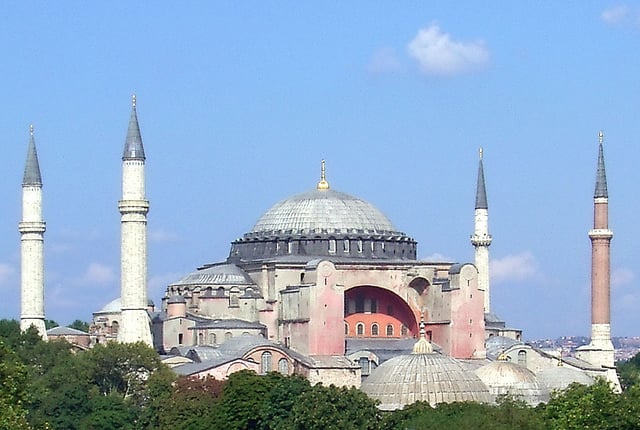
As a symbol and expression of the universal prestige of the Patriarchate of Constantinople, Justinian built the Church of the Holy Wisdom of God, Hagia Sophia, which was completed in the short period of four and a half years (532–537)
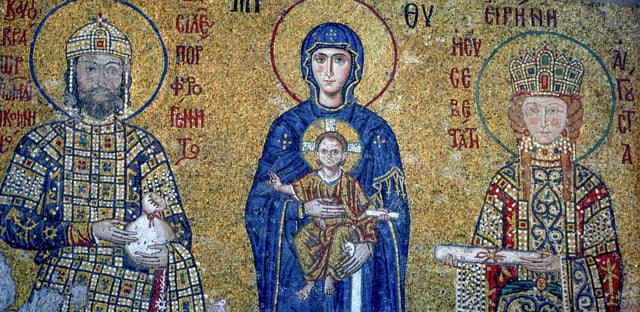
A mosaic from the Hagia Sophia of Constantinople (modern Istanbul), depicting Mary and Jesus, flanked by John II Komnenos (left) and his wife Irene of Hungary (right), 12th century
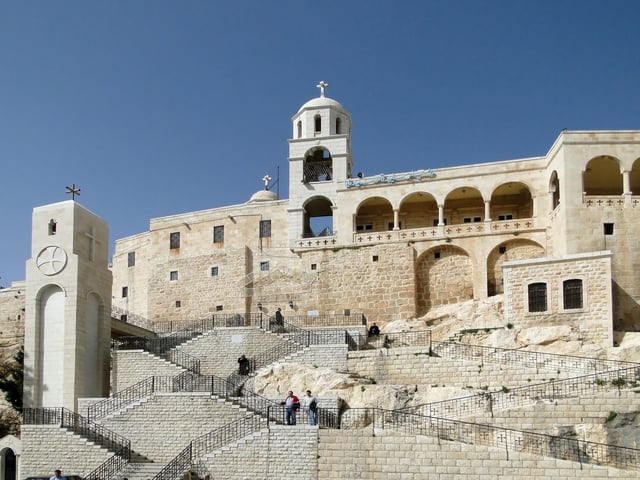
Our Lady of Saidnaya Monastery, in present-day Syria, is traditionally held to have been founded by emperor Justinian I.
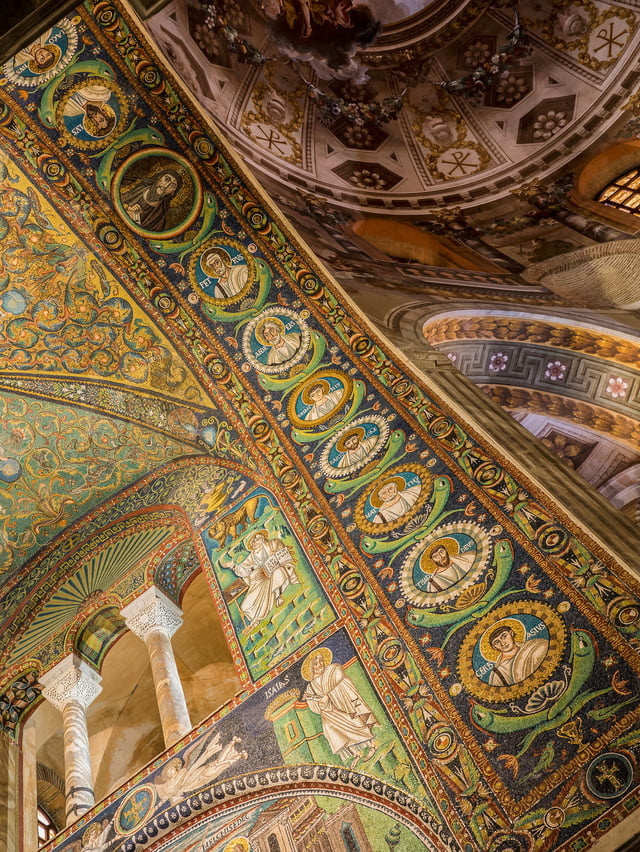
Triumphal arch mosaics of Jesus Christ and the Apostles. In Basilica of San Vitale in Ravenna, Italy.
The Byzantine Empire was a theocracy, said to be ruled by God working through the Emperor. Jennifer Fretland VanVoorst argues, "The Byzantine Empire became a theocracy in the sense that Christian values and ideals were the foundation of the empire's political ideals and heavily entwined with its political goals."[216] Steven Runciman says in his book on The Byzantine Theocracy (2004):
The constitution of the Byzantine Empire was based on the conviction that it was the earthly copy of the Kingdom of Heaven. Just as God ruled in Heaven, so the Emperor, made in his image, should rule on earth and carry out his commandments ... It saw itself as a universal empire. Ideally, it should embrace all the peoples of the Earth who, ideally, should all be members of the one true Christian Church, its own Orthodox Church. Just as man was made in God's image, so man's kingdom on Earth was made in the image of the Kingdom of Heaven.[217]
The survival of the Empire in the East assured an active role of the Emperor in the affairs of the Church. The Byzantine state inherited from pagan times the administrative, and financial routine of administering religious affairs, and this routine was applied to the Christian Church. Following the pattern set by Eusebius of Caesarea, the Byzantines viewed the Emperor as a representative or messenger of Christ, responsible particularly for the propagation of Christianity among pagans, and for the "externals" of the religion, such as administration and finances. As Cyril Mango points out, the Byzantine political thinking can be summarised in the motto "One God, one empire, one religion".[218]
The imperial role in the affairs of the Church never developed into a fixed, legally defined system.[219] On the other way around, with the decline of Rome, and internal dissension in the other Eastern Patriarchates, the Church of Constantinople became, between the 6th and 11th centuries, the richest and most influential center of Christendom;[220] even when the Empire was reduced to only a shadow of its former self, the Church continued to exercise significant influence both inside and outside of the imperial frontiers. As George Ostrogorsky points out:
The Patriarchate of Constantinople remained the center of the Orthodox world, with subordinate metropolitan sees and archbishoprics in the territory of Asia Minor and the Balkans, now lost to Byzantium, as well as in Caucasus, Russia and Lithuania. The Church remained the most stable element in the Byzantine Empire.[221]
Byzantine monasticism especially came to be an "ever-present feature" of the empire, with monasteries becoming "powerful landowners and a voice to be listened to in imperial politics".[222]
The official state Christian doctrine was determined by the first seven ecumenical councils, and it was then the emperor's duty to impose it on his subjects. An imperial decree of 388, which was later incorporated into the Codex Justinianeus, orders the population of the Empire "to assume the name of Catholic Christians", and regards all those who will not abide by the law as "mad and foolish persons"; as followers of "heretical dogmas".[223]
Despite imperial decrees and the stringent stance of the state church itself, which came to be known as the Eastern Orthodox Church or Eastern Christianity, the latter never represented all Christians in Byzantium. Mango believes that, in the early stages of the Empire, the "mad and foolish persons", those labelled "heretics" by the state church, were the majority of the population.[224] Besides the pagans, who existed until the end of the 6th century, and the Jews, there were many followers – sometimes even emperors – of various Christian doctrines, such as Nestorianism, Monophysitism, Arianism, and Paulicianism, whose teachings were in some opposition to the main theological doctrine, as determined by the Ecumenical Councils.[225]
Another division among Christians occurred, when Leo III ordered the destruction of icons throughout the Empire. This led to a significant religious crisis, which ended in the mid-9th century with the restoration of icons. During the same period, a new wave of pagans emerged in the Balkans, originating mainly from Slavic people. These were gradually Christianised, and by Byzantium's late stages, Eastern Orthodoxy represented most Christians and, in general, most people in what remained of the Empire.[226]
Jews were a significant minority in the Byzantine state throughout its history, and, according to Roman law, they constituted a legally recognised religious group. In the early Byzantine period they were generally tolerated, but then periods of tensions and persecutions ensued. In any case, after the Arab conquests, the majority of Jews found themselves outside the Empire; those left inside the Byzantine borders apparently lived in relative peace from the 10th century onwards.[227]
Arts
Art and literature
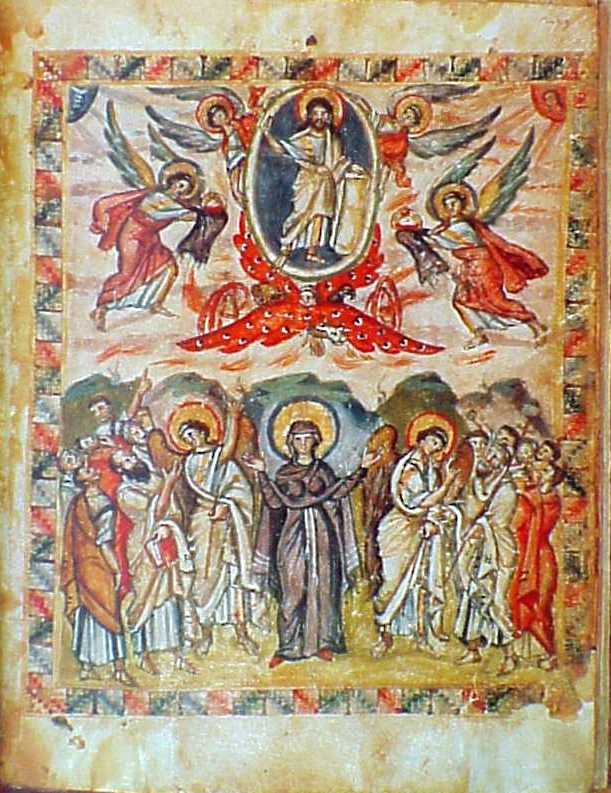
Miniatures of the 6th-century Rabula Gospel display the more abstract and symbolic nature of Byzantine art.
Surviving Byzantine art is mostly religious and with exceptions at certain periods is highly conventionalised, following traditional models that translate carefully controlled church theology into artistic terms. Painting in fresco, illuminated manuscripts and on wood panel and, especially in earlier periods, mosaic were the main media, and figurative sculpture very rare except for small carved ivories. Manuscript painting preserved to the end some of the classical realist tradition that was missing in larger works.[228] Byzantine art was highly prestigious and sought-after in Western Europe, where it maintained a continuous influence on medieval art until near the end of the period. This was especially so in Italy, where Byzantine styles persisted in modified form through the 12th century, and became formative influences on Italian Renaissance art. But few incoming influences affected Byzantine style. With the expansion of the Eastern Orthodox church, Byzantine forms and styles spread throughout the Orthodox world and beyond.[229] Influences from Byzantine architecture, particularly in religious buildings, can be found in diverse regions from Egypt and Arabia to Russia and Romania.
In Byzantine literature, four different cultural elements are recognised: the Greek, the Christian, the Roman, and the Oriental. Byzantine literature is often classified in five groups: historians and annalists, encyclopaedists (Patriarch Photios, Michael Psellus, and Michael Choniates are regarded as the greatest encyclopaedists of Byzantium) and essayists, and writers of secular poetry. The only genuine heroic epic of the Byzantines is the Digenis Acritas. The remaining two groups include the new literary species: ecclesiastical and theological literature, and popular poetry.[230]
Of the approximately two to three thousand volumes of Byzantine literature that survive, only 330 consist of secular poetry, history, science and pseudo-science.[230] While the most flourishing period of the secular literature of Byzantium runs from the 9th to the 12th century, its religious literature (sermons, liturgical books and poetry, theology, devotional treatises, etc.) developed much earlier with Romanos the Melodist being its most prominent representative.[231]
Music
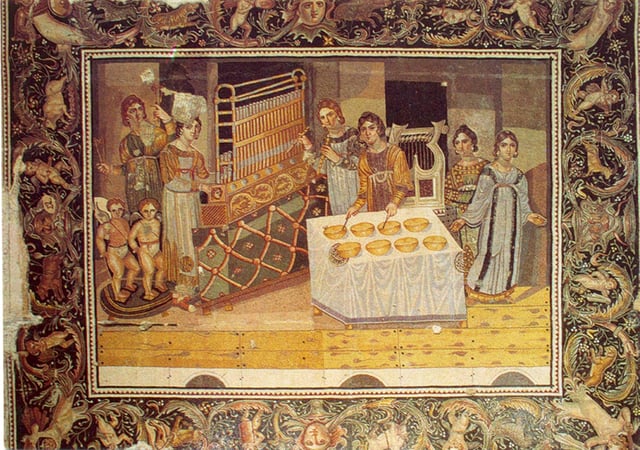
Late 4th century AD "Mosaic of the Musicians" with organ, aulos, and lyre from a Byzantine villa in Maryamin, Syria[232]
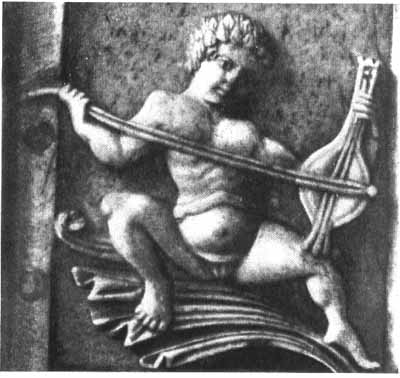
Earliest known depiction of a bowed lyra, from a Byzantine ivory casket (900–1100 AD). (Museo Nazionale, Florence)
The ecclesiastical forms of Byzantine music, composed to Greek texts as ceremonial, festival, or church music,[233] are, today, the most well-known forms. Ecclesiastical chants were a fundamental part of this genre. Greek and foreign historians agree that the ecclesiastical tones and in general the whole system of Byzantine music is closely related to the ancient Greek system.[234] It remains the oldest genre of extant music, of which the manner of performance and (with increasing accuracy from the 5th century onwards) the names of the composers, and sometimes the particulars of each musical work's circumstances, are known.
The 9th century Persian geographer Ibn Khordadbeh (d. 911); in his lexicographical discussion of instruments cited the lyra (lūrā) as the typical instrument of the Byzantines along with the urghun (organ), shilyani (probably a type of harp or lyre) and the salandj (probably a bagpipe).[235] The first of these, the early bowed stringed instrument known as the Byzantine lyra, would come to be called the lira da braccio,[236] in Venice, where it is considered by many to have been the predecessor of the contemporary violin, which later flourished there.[237] The bowed "lyra" is still played in former Byzantine regions, where it is known as the Politiki lyra (lit. "lyra of the City" i.e. Constantinople) in Greece, the Calabrian lira in Southern Italy, and the Lijerica in Dalmatia. The second instrument, the organ, originated in the Hellenistic world (see Hydraulis) and was used in the Hippodrome during races.[238][239] A pipe organ with "great leaden pipes" was sent by the emperor Constantine V to Pepin the Short, King of the Franks in 757. Pepin's son Charlemagne requested a similar organ for his chapel in Aachen in 812, beginning its establishment in Western church music.[239] The aulos was a double reeded woodwind like the modern oboe or Armenian duduk. Other forms include the plagiaulos (πλαγίαυλος, from πλάγιος "sideways"), which resembled the flute,[240] and the askaulos (ἀσκός askos – wine-skin), a bagpipe.[241] Bagpipes, also known as Dankiyo (from ancient Greek: angion (Τὸ ἀγγεῖον) "the container"), had been played even in Roman times and continued to be played throughout the empire's former realms through to the present. (See Balkan Gaida, Greek Tsampouna, Pontic Tulum, Cretan Askomandoura, Armenian Parkapzuk, and Romanian Cimpoi.) The modern descendant of the aulos is the Greek Zourna. Other instruments used in Byzantine Music were Kanonaki, Oud, Laouto, Santouri, Tambouras, Seistron (defi tambourine), Toubeleki and Daouli. Some claim that Lavta may have been invented by the Byzantines before the arrival of the Turks.
Cuisine
Byzantine culture was initially the same as Late Greco-Roman, but over the following millennium of the empire's existence it slowly changed into something more similar to modern Balkan and Anatolian culture. The cuisine still relied heavily on the Greco-Roman fish-sauce condiment garos, but it also contained foods still familiar today, such as the cured meat pastirma (known as "paston" in Byzantine Greek),[242][243][244] baklava (known as koptoplakous κοπτοπλακοῦς),[245] tiropita (known as plakountas tetyromenous or tyritas plakountas),[246] and the famed medieval sweet wines (Commandaria and the eponymous Rumney wine). Retsina, wine flavoured with pine resin, was also drunk, as it still is in Greece today, producing similar reactions from unfamiliar visitors; "To add to our calamity the Greek wine, on account of being mixed with pitch, resin, and plaster was to us undrinkable," complained Liutprand of Cremona, who was the ambassador sent to Constantinople in 968 by the German Holy Roman Emperor Otto I.[247] The garos fish sauce condiment was also not much appreciated by the unaccustomed; Liutprand of Cremona described being served food covered in an "exceedingly bad fish liquor."[247] The Byzantines also used a soy sauce like condiment, murri, a fermented barley sauce, which, like soy sauce, provided umami flavouring to their dishes.[248][249]
Flags and insignia
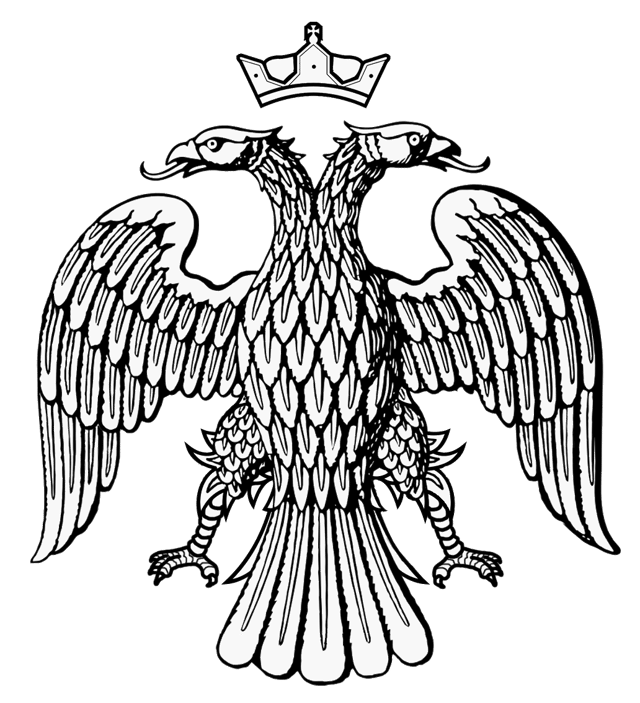
The double-headed imperial eagle, a common Imperial symbol
For most of its history, the Byzantine Empire did not know or use heraldry in the West European sense. Various emblems (Greek: σημεία, sēmeia; sing. σημείον, sēmeion) were used in official occasions and for military purposes, such as banners or shields displaying various motifs such as the cross or the labarum. The use of the cross, and of images of Christ, the Virgin Mary and various saints is also attested on seals of officials, but these were personal rather than family emblems.[250]
Double-headed eagle
Tetragrammic cross
Language
Apart from the Imperial court, administration and military, the primary language used in the eastern Roman provinces even before the decline of the Western Empire was Greek, having been spoken in the region for centuries before Latin.[252] Following Rome's conquest of the east its 'Pax Romana', inclusionist political practices and development of public infrastructure, facilitated the further spreading and entrenchment of Greek language in the east. Indeed, early on in the life of the Roman Empire, Greek had become the common language of the Church, the language of scholarship and the arts, and to a large degree the lingua franca for trade between provinces and with other nations.[253] Greek for a time became diglossic with the spoken language, known as Koine (eventually evolving into Demotic Greek), used alongside an older written form (Attic Greek) until Koine won out as the spoken and written standard.[254]
The emperor Diocletian (r. 284–305) sought to renew the authority of Latin, making it the official language of the Roman administration also in the East, and the Greek expression ἡ κρατοῦσα διάλεκτος (hē kratousa dialektos) attests to the status of Latin as "the language of power."[255] In the early 5th century, Greek gained equal status with Latin as official language in the East and emperors gradually began to legislate in Greek rather than Latin starting with the reign of Leo I the Thracian in the 460s.[256] The last Eastern emperor to stress the importance of Latin was Justinian I (r. 527–565), whose Corpus Juris Civilis was written almost entirely in Latin. He may also have been the last native Latin-speaking emperor.[257]
The use of Latin as the language of administration persisted until adoption of Greek as the sole official language by Heraclius in the 7th century. Scholarly Latin would rapidly fall into disuse among the educated classes although the language would continue to be at least a ceremonial part of the Empire's culture for some time.[258] Additionally, Latin remained a minority language in the Empire, mainly on the Italian peninsula and along the Dalmatian coast, eventually developing into various Romance languages like Dalmatian.[259]
Many other languages existed in the multi-ethnic Empire, and some of these were given limited official status in their provinces at various times.[260] Notably, by the beginning of the Middle Ages, Syriac had become more widely used by the educated classes in the far eastern provinces.[261] Similarly Coptic, Armenian, and Georgian became significant among the educated in their provinces.[262] Later foreign contacts made Old Church Slavic, Middle Persian, and Arabic important in the Empire and its sphere of influence.[263] There was a revival of Latin studies in the 10th century for the same reason and by the 11th century knowledge of Latin was no longer unusual at Constantinople.[264] There was widespread use of the Armenian and various Slavic languages, which became more pronounced in the border regions of the empire.[260]
Aside from these languages, since Constantinople was a prime trading center in the Mediterranean region and beyond, virtually every known language of the Middle Ages was spoken in the Empire at some time, even Chinese.[265] As the Empire entered its final decline, the Empire's citizens became more culturally homogeneous and the Greek language became integral to their identity and religion.[266]
Recreation

A game of τάβλι (tabula) played by Byzantine emperor Zeno in 480 and recorded by Agathias in c. 530 because of a very unlucky dice throw for Zeno (red), as he threw 2, 5 and 6 and was forced to leave eight pieces alone.[267]
Byzantines were avid players of tavli (Byzantine Greek: τάβλη), a game known in English as backgammon, which is still popular in former Byzantine realms, and still known by the name tavli in Greece.[267] Byzantine nobles were devoted to horsemanship, particularly tzykanion, now known as polo. The game came from Sassanid Persia in the early period and a Tzykanisterion (stadium for playing the game) was built by Theodosius II (r. 408–450) inside the Great Palace of Constantinople. Emperor Basil I (r. 867–886) excelled at it; Emperor Alexander (r. 912–913) died from exhaustion while playing, Emperor Alexios I Komnenos (r. 1081–1118) was injured while playing with Tatikios, and John I of Trebizond (r. 1235–1238) died from a fatal injury during a game.[268][269] Aside from Constantinople and Trebizond, other Byzantine cities also featured tzykanisteria, most notably Sparta, Ephesus, and Athens, an indication of a thriving urban aristocracy.[270] The game was introduced to the West by crusaders, who developed a taste for it particularly during the pro-Western reign of emperor Manuel I Komnenos.
Economy
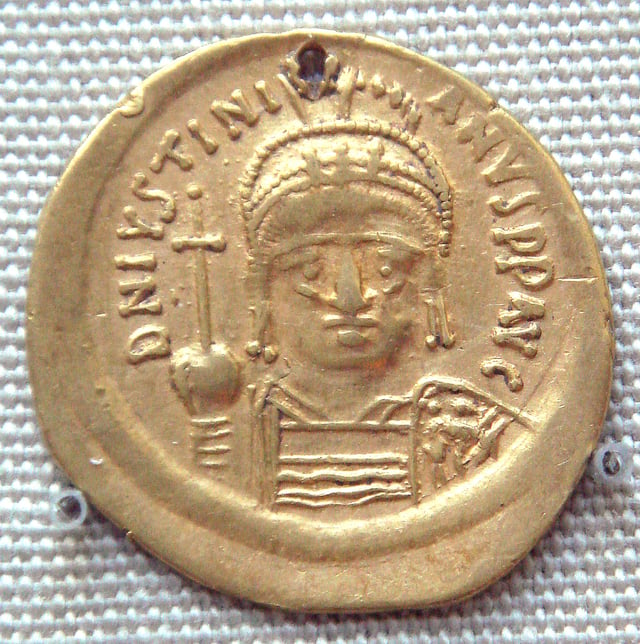
Gold coin of Justinian I (527–565 CE) excavated in India probably in the south, an example of Indo-Roman trade during the period.
The Byzantine economy was among the most advanced in Europe and the Mediterranean for many centuries. Europe, in particular, could not match Byzantine economic strength until late in the Middle Ages. Constantinople operated as a prime hub in a trading network that at various times extended across nearly all of Eurasia and North Africa, in particular as the primary western terminus of the famous Silk Road. Until the first half of the 6th century and in sharp contrast with the decaying West, the Byzantine economy was flourishing and resilient.[271]
The Plague of Justinian and the Arab conquests would represent a substantial reversal of fortunes contributing to a period of stagnation and decline. Isaurian reforms and Constantine V's repopulation, public works and tax measures marked the beginning of a revival that continued until 1204, despite territorial contraction.[272] From the 10th century until the end of the 12th, the Byzantine Empire projected an image of luxury and travellers were impressed by the wealth accumulated in the capital.[273]
The Fourth Crusade resulted in the disruption of Byzantine manufacturing and the commercial dominance of the Western Europeans in the eastern Mediterranean, events that amounted to an economic catastrophe for the Empire.[273] The Palaiologoi tried to revive the economy, but the late Byzantine state would not gain full control of either the foreign or domestic economic forces. Gradually, Constantinople also lost its influence on the modalities of trade and the price mechanisms, and its control over the outflow of precious metals and, according to some scholars, even over the minting of coins.[274]
One of the economic foundations of Byzantium was trade, fostered by the maritime character of the Empire. Textiles must have been by far the most important item of export; silks were certainly imported into Egypt, and appeared also in Bulgaria, and the West.[275] The state strictly controlled both the internal and the international trade, and retained the monopoly of issuing coinage, maintaining a durable and flexible monetary system adaptable to trade needs.[276]
The government attempted to exercise formal control over interest rates, and set the parameters for the activity of the guilds and corporations, in which it had a special interest. The emperor and his officials intervened at times of crisis to ensure the provisioning of the capital, and to keep down the price of cereals. Finally, the government often collected part of the surplus through taxation, and put it back into circulation, through redistribution in the form of salaries to state officials, or in the form of investment in public works.[276]
Legacy

King David in robes of a Byzantine emperor; miniature from the Paris Psalter
Byzantium has been often identified with absolutism, orthodox spirituality, orientalism and exoticism, while the terms "Byzantine" and "Byzantinism" have been used as bywords for decadence, complex bureaucracy, and repression. Both Eastern and Western European authors have often perceived Byzantium as a body of religious, political, and philosophical ideas contrary to those of the West. Even in 19th-century Greece, the focus was mainly on the classical past, while Byzantine tradition had been associated with negative connotations.[277]
This traditional approach towards Byzantium has been partially or wholly disputed and revised by modern studies, which focus on the positive aspects of Byzantine culture and legacy. Averil Cameron regards as undeniable the Byzantine contribution to the formation of medieval Europe, and both Cameron and Obolensky recognise the major role of Byzantium in shaping Orthodoxy, which in turn occupies a central position in the history and societies of Greece, Romania, Bulgaria, Russia, Georgia, Serbia and other countries.[278] The Byzantines also preserved and copied classical manuscripts, and they are thus regarded as transmitters of classical knowledge, as important contributors to modern European civilisation, and as precursors of both Renaissance humanism and Slav Orthodox culture.[279]
As the only stable long-term state in Europe during the Middle Ages, Byzantium isolated Western Europe from newly emerging forces to the East. Constantly under attack, it distanced Western Europe from Persians, Arabs, Seljuk Turks, and for a time, the Ottomans. From a different perspective, since the 7th century, the evolution and constant reshaping of the Byzantine state were directly related to the respective progress of Islam.[279]
Following the conquest of Constantinople by the Ottoman Turks in 1453, Sultan Mehmed II took the title "Kaysar-i Rûm" (the Ottoman Turkish equivalent of Caesar of Rome), since he was determined to make the Ottoman Empire the heir of the Eastern Roman Empire.[280]
See also
Byzantine Army
Byzantine philosophy
Index of Byzantine Empire-related articles
Legacy of the Roman Empire
Family trees of the Byzantine imperial dynasties
List of Byzantine inventions
List of Byzantine revolts and civil wars
List of Byzantine wars
Despotate of the Morea


